- Skip to main content
- Skip to "About this site"

Language selection
- Français
- Search and menus
Canada at a Glance, 2022 Travel and tourism
- Table 23 Top domestic activities by decrease and by increase, third quarter 2021 compared with third quarter 2019
- Chart 31 Non-resident visitors arriving in Canada by commercial aircraft, June, 2019 to 2022
- Chart 32 Passengers carried by Canadian Level I air carriers, monthly, 2019 to 2022
Travel and tourism… in brief
With the onset of the COVID-19 pandemic in 2020, travel and tourism were among the first- and hardest-hit sectors of the Canadian economy. Travel restrictions, border closures and business closures drastically curtailed non-resident arrivals to Canada and altered the travel behaviour of Canadians. As a result, some passenger industries, including airlines and urban transit, were devastated, while others continued to provide essential freight services, including rail and trucking. The food and accommodation industries, along with travel agencies and charter and sight-seeing activities suffered as the flow of international visitors to Canada was reduced to a trickle.

Did you know?
- April 2020 marked the first full month of border restrictions enacted around the world, which brought international travel to and from Canada to a virtual stop. The number of non-domestic arrivals to Canada from overseas countries (countries other than the United States) fell by 96.6%, while those from the United States were down 96.8%.
- Over two years later, in June 2022, the number of international arrivals landing at Canadian airports was nearing levels recorded before the pandemic. Estimates of non-resident visitors totalled 846,700, up sharply compared with the 26,200 arrivals observed in June 2021.

- The impact of the COVID-19 pandemic was far more damaging to the airline industry than any other global event, including the terrorist attacks of September 11, 2001, or the severe acute respiratory syndrome (SARS) outbreak in 2003, which were both associated with year-over-year drops of more than 25% in air passengers. In April 2020, Canada’s airlines reported a year-over-year drop of 97.0% in passengers carried.
- Just over two years later, in May 2022, the 5.3 million passengers on scheduled and charter services reported by Canada’s major airlines were the highest monthly total since before the pandemic. The industry has now recovered over three-quarters (77.3%) of its pre-pandemic traffic.
- During the busy summer travel season, from July to September 2021, fewer Canadians attended festivals or fairs, performances such as plays or concerts, or sporting events as spectators. Compared with the same period in 2019, relatively fewer Canadians reported attending such events, with declines of 82.1% for fairs and festivals, 74.5% for performances such as plays and concerts, and 48.2% for sporting events.
- By contrast, over the same period, more Canadians were engaging in outdoor activities. For example, relatively more travellers reported hiking or backpacking (+47.8%), cycling (+42.7%) and golfing (+35.9%) in the summer of 2021 as part of their domestic vacations.
To learn more
Travel and tourism statistics (statcan.gc.ca)
More information
Note of appreciation.
Canada owes the success of its statistical system to a long-standing partnership between Statistics Canada, the citizens of Canada, its businesses, governments and other institutions. Accurate and timely statistical information could not be produced without their continued co-operation and goodwill.
Standards of service to the public
Statistics Canada is committed to serving its clients in a prompt, reliable and courteous manner. To this end, the Agency has developed standards of service which its employees observe in serving its clients.
Published by authority of the Minister responsible for Statistics Canada.
© His Majesty the King in Right of Canada, as represented by the Minister of Industry, 2022
All rights reserved. Use of this publication is governed by the Statistics Canada Open Licence Agreement .
Catalogue no. 12-581-X
Frequency: Annual
Table of contents
Main page A word from the Chief Statistician Population Immigration Racialized groups Indigenous People Accessibility and persons with disabilities LGBTQ2+ people Women Health Education Criminality Digital society Housing Prices and inflation Impacts of COVID-19 Labour Economy International trade Travel and tourism Agriculture Environment For more information
Please note: For an optimal experience, dashboard data is best viewed on a laptop or desktop computer, due to the complexity of the data presented.
Search This Site...
Top Search Terms
- Featured Reports
Tourism Outlook
- Traveller Behaviour
- City Comparative

Welcome to the Canadian Tourism Data Collective
Fueling canada's hosting economy.
The Canadian Tourism Data Collective is a new, centralized national platform that will serve as a two-way street for sharing and accessing tourism data. The Data Collective harnesses the power of data, research, and insights (and that’s a lot of power!) and shares information in an accessible and secure environment that encourages collaboration and conversation across and beyond the tourism ecosystem.
About us & FAQ
Here’s How It Works
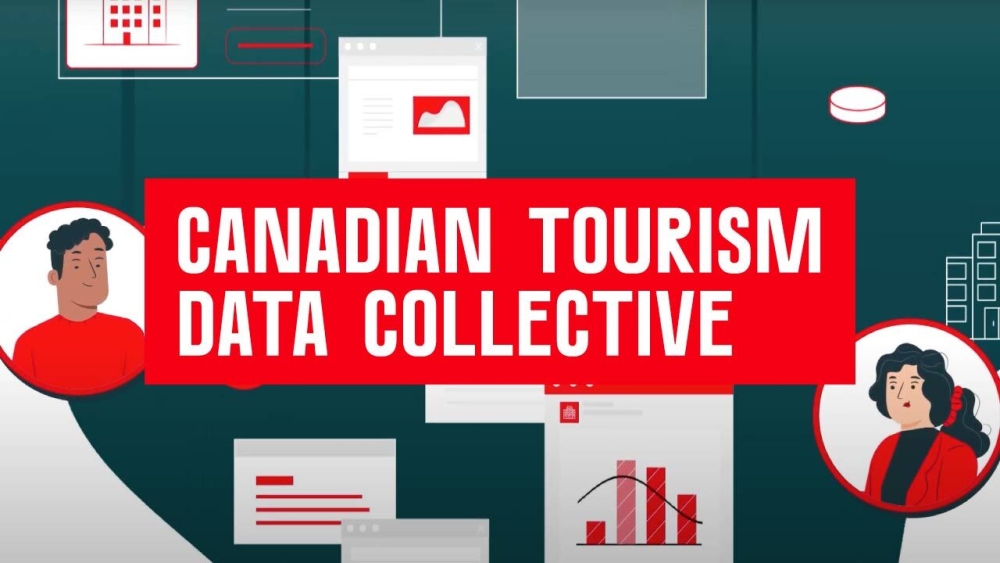
Tourism Performance Indicators
Designed for industry stakeholders and Canadians who want to understand the current state of Canada’s tourism industry, explore the latest data and recent trends on tourism visitation and revenue.
Explore the Data
Source: Statistics Canada, Table 24-10-0055-01
Total overnight arrivals year-to-date (Jun. 2024)
Year-over-Year growth year-to-date (Jun. 2024)
Proportion of 2019 levels year-to-date (Jun. 2024)
Total tourism revenue year-to-date (Q1 2024)
115% proportion of 2019 levels +5% year-over-year growth
Domestic tourism revenue year-to-date (Q1 2024)
121% proportion of 2019 levels +5% year-over-year growth
International tourism revenue year-to-date (Q1 2024)
97% proportion of 2019 levels +7% year-over-year growth
Source: Statistics Canada, National Tourism Indicators
Data and Insights On Demand
Anticipate future tourism spending and activity based on global and domestic travel trends. Plan strategically and with confidence, aligning tourism activities with forecast travel patterns.
Forecast future tourism visitation and spending driven by domestic and international travel, exploring multiple potential paths for growth opportunities.
Track and analyze the health of Canada’s tourism sector at a glance, with timely insights into key performance indicators such as visitor arrivals, traveller spending, and occupancy rates.
Examine the value and impact of tourism in communities across Canada with destination-focused insights that drill deep into tourism spending by region.
Wealth & Wellbeing Index - Preview
Monitor tourism’s impact in economic, social, and environmental sustainability and resilience at both national and provincial/territorial levels with this comprehensive benchmark.
TourismScapes
Scale and plan your tourism efforts using geospatial data that provides insights into hosting economies.
Discover what motivates people to travel, explore factors influencing travel behaviours, and learn about travellers' perceptions of Canada as a destination through in-depth, timely visitor data from Destination Canada’s key markets.
Global Traveller Research Program (GTRP) - More coming soon!
Develop destination-specific marketing strategies and make informed strategic decisions with traveller intelligence from DC’s target markets.
Segmentation Program - Coming soon!
Analyzes psychographics and behaviours of travellers in Destination Canada’s top 10 markets to create in-depth profiles of traveller values and motivators.
Canadian Travel Insights
Use robust and timely insights on Canadian travel consumer perceptions, attitudes, behaviours, and motivators to inform smart tourism planning.
Develop place-specific marketing strategies and make informed strategic decisions with traveller intelligence from Destination Canada's target markets.
Scale and plan your tourism efforts using geospatial data that provides insights into local hosting economies.
Use robust and timely insights on Canadian travel consumer perceptions, attitudes, behaviours, and motivators to inform smart tourism planning.
Latest Reports

Quarterly Tourism Snapshot
Quarterly Tourism Snapshot - Q1 2024, an ongoing monitor of the performance of Canada's tourism sector.
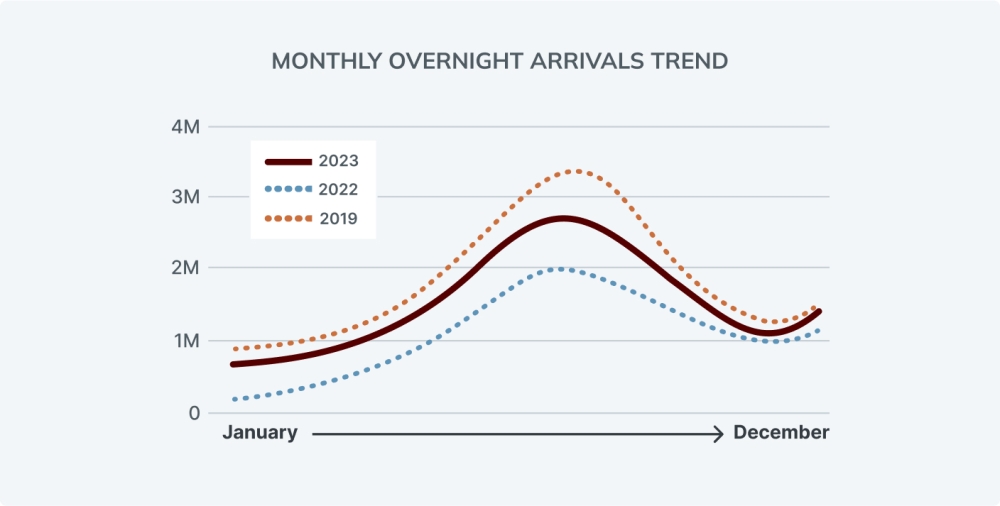
Year-in-Review Overnight Arrivals
Annual research infographic summarizing annual data on international overnight arrivals to Canada in 2023.

Monthly Overnight Arrivals
Monthly research infographic summarizing the latest data on international overnight arrivals to Canada in June 2024.

Sign Up for Destination Canada News
Stay in the know – get the latest Destination Canada news and updates delivered straight to your inbox.
Subscribe and get the latest Destination Canada news and updates delivered straight to your inbox.
SIGN UP NOW
Do you currently work in the tourism industry? *
What type of tourism data is priority for you?
- Tourism Performance
- Tourism Indicators
- Traveller and Marketing Insights
- Tourism Outlook and Forecast
- Destination Development
- Tourism Advancement and Global Competitiveness
- Social License and Resident Sentiment
- Air Capacity and Connectivity
- Accommodation and Occupancy
- Sustainability
- Tour Operators
- Destinations
- Hotels & Resorts
- Agent Feedback
Deals & Incentives
- On Location
- Industry Experts
- Sphere – HomeBased
Digital Editions
- Subscribe today!
- Hotels and Resorts
- Types of Travel
Subscribe Now
Top Story Berlin, Saxony, Rothenburg and more: GNTO’s destination partners shine bright

Hotels and Resorts Free connectors with ACV for Sandals and Beaches Resorts in Jamaica

Contests Travel agent portal WheelsUpNetwork rebrands to Global Agents

Airlines Low pay for junior Air Canada pilots poses possible hurdle to proposed deal
Sign Up for Travelweek
More Featured News

Policies Airlines could be charged millions in new fee proposal from transport regulator

Cruise What’s new for Uniworld in 2025: A new ship, itineraries and cruise extensions

Destinations Floods in Central Europe threaten new areas; heavy rains also flood parts of Italy

Airlines Alaska Airlines completes its acquisition of Hawaiian Air, which will remain a separate brand

Hotels and Resorts What’s the RIU difference? “Service, and the best value for money,” says Kaestner
Nassau Paradise

Beach Bound: Guide to Experiencing the Beautiful Beaches of The Bahamas

Where to Eat in Nassau & Paradise Island in 2024

Top 9 Couples’ Experiences in Nassau & Paradise Island

Eco-Friendly Adventures in Nassau & Paradise Island
Marketplace
Pc – voyages: accounting and bookkeeping specialist, manulife – business development manager.
- Submit a Job

Travel Agent Partner Familiarization Trips Ghana 2024-2025

Save the date for special St. Maarten fam this December

Annual Conference – THIA Events 2024

Granite Events – Fall 2024 Ontario
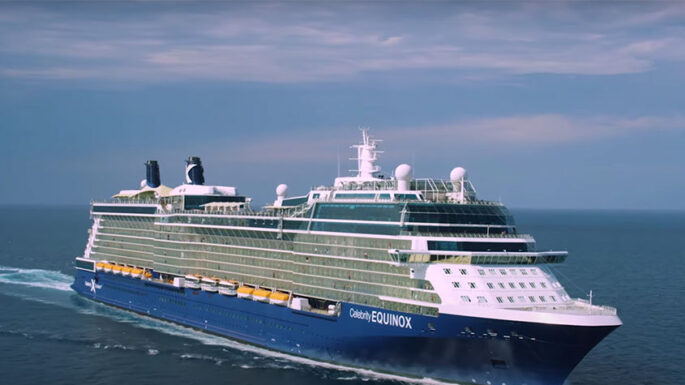
Luxury Caribbean Cruise on Celebrity Cruises
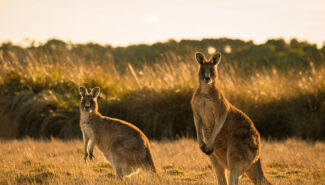
Join us Down Under and Start Exploring all that Australia has to Offer

Germany is open, and we are thrilled to welcome you back!

WestJet’s new video is the ultimate feel-good, holiday tear-jerker
Top news of the week.

Destinations Berlin, Saxony, Rothenburg and more: GNTO’s destination partners shine bright

Learning Centre
“You are not just a number at TTAND” and here’s why

The power of routine: How travel advisors can thrive as summer ends

How to ramp up your productivity

Nexion Travel Group names 2024 winners; Foster shares plans to step down

travelweek September 12, 2024

travel professional Fall 2024

Cruise TravelBrands adds Riverside Luxury Cruises to its portfolio
Agent feedback sponsored by sphere.

Kathleen Penner’s can-do attitude with Canva proves inspiring for many more agents

Survey shows growth in home based agents, new entrants during pandemic

Tips from a veteran travel advisor on how to close the sale and set service fees

Insights and inspiration from 2023: A memorable year for the industry, and for Travelweek
Travelweek group, travelweek has been keeping travel agents up to date with the latest news for more than 40 years..
In addition to the weekly printed Travelweek publication and monthly Travel Professional, we have many exciting digital marketing channels like Travelweek Daily newsletter, the Learning Centre and French-language Profession Voyages, plus full warehousing and distribution capabilities with ENVOY Networks.
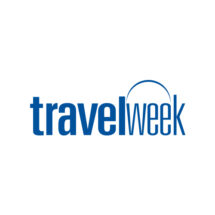

Founded in 1930 to encourage the development of tourism in Canada, TIAC serves today as the national private-sector advocate for this once $105 billion sector. Based in Ottawa, TIAC takes action on behalf of Canadian tourism businesses and promotes positive measures that help the industry grow and prosper.
TIAC is responsible for representing tourism interests at the national level, and its advocacy work involves promoting and supporting policies, programs and activities that will benefit the sector's growth and development.
TIAC's membership reflects partnerships among all sectors of the industry, and provincial, territorial and regional tourism associations, enabling the association to address the full range of issues facing Canadian tourism.
Vision and Mission
Our vision: To lead the Canadian tourism industry to be the most competitive in the world.
Our mission: To be the voice of Canada’s tourism industry and improve its global competitiveness as an international destination through leadership and advocacy.
- Secured permanent base funding for Destination Canada funding to $95.5 million per year;
- $8.6 million dedicated to Aboriginal Tourism development through Indigenous and Northern Affairs Canada;
- $13.6 million dedicated to Statistics Canada’s collection of tourism statistics, including provincial data collection;
- Significant investments to maintain Parks Canada land and the Trans-Canada trail;
- Significant infrastructure investments supporting tourism industry;
- Successful Trade Mission to China in October 2016 through government funding to offset costs for SMEs;
- Announcements for 7 new visa application centers (VACs) in China;
- Promoted and achieved the expansion of the number of Visa Application Centres (VACs) to 135 worldwide;
- Mexican visa requirements lifted completely, and Brazilian, Romanian and Bulgarian visas lifted for eligible travellers;
- TIAC’s recommendations to reduce aviation costs in the Canada Transportation Act included in expert panel’s final report;
- Introduction of new ten-year multiple entry visa, facilitating repeat visitors to Canada in select markets; and more …
TIAC Successes

2022 Successes
- Held CRA sessions on C-2 support programs for Coalition members to have questions answered
- Submitted a comprehensive pre-budget submission to the federal government with industry input and support positioning key advocacy recommendations into three priority areas: Financial Supports; Branding and Barriers and the Labour Shortage LINK
- Successfully advocated for testing requirements to be updated to include the option of antigen pre-arrival test for fully vaccinated travellers o Held an industry-wide briefing with Public Health Agency of Canada
- Hosted a successful Hill Week from February 15-17, 2022 with over 50 meetings
- Restart of the cruise in Canadian waters – much work and advocacy done by the TIAC Cruise Committee
- Significant work undertaken with Tourism HR Canada and government partners to begin addressing the tourism labour challenge
- Successfully advocated for testing requirements to be updated to remove the requirement for pre-travel testing, and move mandatory random testing offsite
- Submitted a comprehensive submission to the federal government with input from national counterparts and members across the country, in advance of the new Federal Tourism Growth Strategy LINK
2021 Successes
- After months of advocating for sector specific support, Bill C-2 passed on December 17th. The new support ensures Canada's Tourism Industry; the "Hardest Hit Sector" will continue to receive wage and rent relief and save thousands of businesses and jobs. LINK
- TIAC welcomed the reintroduction of a Minister of Tourism with the appointment of the Honourable Randy Boissonnault as the new Minister of Tourism and Associate Minister of Finance. LINK
- Tourism and Hospitality Recovery Program : We knew that the wage and rent subsidy programs were slated to sunset at the end of October. So, we continued to push for a tailored solution. A demonstration of our efforts came when, as the first commitment on the campaign trail, Prime Minister Trudeau announced support for the hardest hit sectors, including a transition program that was very much aligned with the survival plan the Coalition had been advocating for. TIAC wrote many letters, made many phone calls, set up many meetings with Members of Parliament, Department officials and Senators, and appeared before the Standing Committee on Finance, as well as countless times in the media fighting for this bill. In December, we saw the greatest acknowledgement of these efforts. Bill C2: An Act to provide further support in response to COVID-19 was passed by both the House of Commons and the Senate. LINK
- The Prime Minister announced a standardized Canadian COVID-19 proof of vaccination, noting that Canada was engaging with international partners to obtain recognition abroad, so the tool could be used to facilitate travel around the world. This was a win for the tourism industry as TIAC had been advocating for one pan Canadian proof of vaccination system. We know that since then there is much confusion regarding the Omicron variant and the changing travel rules and restrictions. Our biggest priority through this is clarity for the industry, and ensuring we continue to advocate for one process. As we start to see provinces and territories reacting with their own measures, we need to ensure we are vocalizing the need to not move backwards into a fragmented system. LINK
- The U.S. accepted travelers immunized with vaccines approved by the WHO– including Canadians who have received the Oxford-AstraZeneca vaccine. Encouraged to see this as TIAC continues to advocate for a national proof of vaccination in Canada, and for travelers with vaccinations approved by the WHO - in addition to those approved by Health Canada - to be welcomed back. LINK
- The lifting of the government's international ban on non-essential travel was very welcome as we continue to build consumer confidence in travel again. TIAC advocated for this through the Coalition of Hardest Hit Businesses.
- The ban on cruise in Canadian waters was rescinded four months early due to advocacy work. Effective November 1, 2021, cruise ships were permitted in Canadian waters. Canada is working with the cruise ship industry, and other domestic and international partners, to support safe cruise ship travel in spring 2022. This allowed for ability to plan for 2022 season. LINK
- TIAC has been working tirelessly with industry partners requesting targeted support for the tourism industry. The TRF provided $500 Million in support for the tourism sector over a two-year period. The majority of the funding, $485 million, will be delivered by Regional Development Agencies (RDAs) directly to tourism businesses and organizations to help aide in the creation of new tourism experiences, or enhance existing ones. Of this $485 million, a minimum of 10% will be invested in Indigenous tourism projects. LINK
- TIAC announced the launch of the #OpentheBorder campaign, calling on the federal government to commit to a plan for reopening the Canada-U.S. border. The campaign focused on getting Canadian decision-makers to acknowledge the urgent need and to commit to a date to open the border, before the summer tourism season was lost. As a part of this campaign, TIAC hosted a number of Parliamentary and Congressional panels to discuss border reopening. The first included Beth Potter, MP Wayne Easter, Congressman Brian Higgins, and political reporter Althia Raj.
- Two press conferences with ALL PTTIAs (13) involved and supporting Tourism Week and the Open the Border campaign
- TIAC formed a national Cruise Committee, comprised of representatives from the five cruise regions: Atlantic Canada, Quebec, Ontario, British Columbia and Northern Canada. This advisory committee works hand in hand with TIAC to identify cruise-related issues and provide recommendations.
- Relaunch of Tourism Round Table - TIAC as Co Chair. The Roundtable is focused on raising awareness on the barriers to travel and tourism caused by restrictions and testing requirements. We know there are more effective ways to protecting Canadians while also encouraging and facilitating travel. LINK
- Sector-specific acknowledgment for tourism in 2021 Federal Budget. LINK
- Hosted Industry Webinars providing updates on industry support efforts and partner plans. LINK
- Launch of TIAC 'Member Talk' - a monthly session open to membership to ask questions to the TIAC senior team. LINK
- Coordination of Town Hall events in partnership with Destination Canada and provincial and territorial associations. LINK
- Government announced a program change to CEWS to base year-to-date revenue comparison on 2019 revenue. LINK
- Coordinating the 2021 Tourism Week campaign for industry coast to coast to coast. Encouraging Canadians to take the Tourism Week pledge to travel in Canada this year. TIAC and tourism Week was featured on many significant media outlets. Tourism Week kicked off with a press conference held on May 21 at 11am EST. Representatives from every Provincial and Territorial Association were in attendance, as well as Destination Canada. A big focus of this year’s Tourism Week was on showcasing the solidarity of the industry, and celebrating its resilience. 34 individual media registered for the conference, including CBC, National Geographic and the Globe and Mail. A press release was distributed following the conference, followed by press releases each day from May 23 – May 30. TIAC highlighted a different region of the country each day of Tourism Week. LINK
- Coordination and execution of 2021 virtual advocacy days including TIAC Board Members in advance of the 2021 Federal Budget. Coordinated our first-ever, virtual Hill Week, online meetings with over 100 MPs.. LINK
- Launch of the 2021 Tourism Recovery Plan developed by the Tourism Recovery Committee. Comprised of tourism leaders from across Canada, representing all sectors of the visitor economy. It produced 2 reports with recommendations. This group met on a weekly basis to share status updates, ideas, and participate in dialogue on challenges and priorities for policy change and emergency support programs. LINK
- RRRF Funding Dedicated to Tourism outlined in Fall Economic Statement.
- Through TIAC's advocacy, HASCAP rollout was expedited and became available to industry in February 2021. LINK
- Elevating Canadian Experiences National Program delivered more than 100 capacity-building sessions in both culinary tourism development and winter/shoulder season development to over 4000 tourism operators and destination partners in 2020 and early 2021. We also supported the development of nine regional tourism development strategies. We also developed a suite of legacy tools from the program that is available to all Canadian tourism operators and destination partners. LINK
- Deployment of a weekly COVID-19 update outlining media and advocacy updates for the industry. LINK
- The undertaking of no less than six industry surveys including analysis of data and dissemination of information to stakeholders and partners on the state of the industry as well as the federal government on the effectiveness of relief programs. LINK
2020 Successes
- The Tourism Industry Association of Canada named one of WTM Virtual World Travel Leaders, the annual recognition of companies and individuals from around the globe which have had a positive impact on a specific region or sector. LINK
- Commissioned the State of the Industry Report, a monthly snapshot of recent global, regional and domestic tourism health and economic updates, and insights on the impact of COVID-19 on the travel and tourism industry’s path to recovery. LINK
- Partnership with The Globe and Mail to encourage Canadians to choose a summer holiday exploring Canada. LINK
- Successful execution of the first-ever virtual Tourism Congress with over 3,000 registered attendees. LINK
- Specific mention and recognition of tourism in the November 2020 Fall Economic Statement. LINK
- Hardest Hit mentioned in speech from the throne and fall economic statement through efforts with the Coalition of Hardest Hit Businesses. LINK
- Tweaks to CEWs, CERS, other relief programs for tourism.
- Immigration rates
- Coordination of Town Hall events in partnership with Destination Canada and provincial and territorial associations.
- Development and deployment of a weekly COVID-19 update outlining media and advocacy updates for the industry. LINK
- As a result of COVID, DC has redirected $30M through Provincial Marketing Organizations to support DMO marketing campaigns.
- $40M through the RRRF fund is directed to support DMOs.
- TIAC hosted 2020 Tourism Week.
- Introduction of a COVID recovery plan.
- Wage subsidy program (CEWS) to keep labour force employed +CERB program to help those who have lost their jobs weather the storm + Changes to EI program to support laid-off employees - Recent promises in the Throne Speech indicate that this program will be extended through summer 2021.
- Creation of the COVID-19 Recovery Committee, with representation from regions across Canada and from all sectors of the tourism economy.
- Work Share program extended from 38 to 76 weeks – allowing businesses operating at lower capacity to keep employees on the payroll and share resources.
- Waived EI waiting period for those in quarantine.
About our Membership
TIAC's membership is as diverse as our country itself. We represent:
- Over 600 members and thousands of affiliate members from coast to coast to coast
- Over 1.8 million Canadians whose jobs depend on the economic activity generated by travel and tourism
- Large national and multinational companies as well as small- and medium-sized enterprises
- Airports, attractions, concert halls, convention centres, duty-free shops, festivals & events, restaurants & foodservices, arenas, transportation, travel services, travel trades, destination and provincial/territorial marketing organizations, suppliers, travel media, and educational institutions
Join TIAC today
For additional information
Please contact:
Jennifer Taylor Vice-President, Business Development & Member Relations 902-698-0984 [email protected]
- Meet The TIAC Senior Team
- Board of Directors
- Advisory Committees
- RFP: Tourism Congress & Canadian Tourism Awards
Join our mailing list
- Visit Parliament Visit
- Français FR
Research publications
About this publication
Executive Summary
1 introduction, 2 global travel and tourism, 3.1 general, 3.2 key details for 2019, 3.3 travel by canadians, 3.4 indigenous tourism, 3.5 canada–united states tourism, 3.6 international competitiveness, 4.1 destination canada, 4.2 federal tourism strategy, 4.3.1 2008–2013, 4.3.2 2016–2017, 4.3.3 2019, 4.3.4 2021, 4.4 other government players, 5 looking ahead.
Canada’s multi-billion-dollar tourism sector employs hundreds of thousands of Canadians and is supported by all levels of government.
In 2020, due to the COVID-19 pandemic, global tourism and travel sector revenue decreased by 49% from the previous year, to US$4.7 trillion. Global tourism employment fell by 19% to 272 million jobs. Similarly, the Canadian sector earned $49.5 billion in 2020, a decline of 40% from 2019, while domestic employment fell to 1.6 million direct and indirect jobs, a decrease of 24%. About 28% of Canadian tourism revenue is generated from inbound visits.
In 2019, Canadians made 37.8 million foreign trips consisting mainly of 27.1 million visits to the United States. Additionally, Canadians made 10.7 million trips to other countries, most frequently Mexico (1.8 million), Cuba (964,000), the United Kingdom (770,000), China (666,000) and Italy (619,000).
According to the World Economic Forum’s Travel & Tourism Competitiveness Report 2019 , which ranks the most competitive countries for travel and tourism, Canada ranked ninth out of 140 countries studied, down from eighth place in 2013. Canada ranked first in several sub-categories, such as safety and security, environmental sustainability and air transport infrastructure. Conversely, Canada was found to be deficient in several areas, including price competitiveness and international openness.
Other studies have found that tourism demand is concentrated in Canada’s largest cities, with Toronto, Vancouver and Montréal accounting for 75% of overall visitors and most of this activity taking place during the summer months. There are also challenges stemming from labour shortages, a lack of investment and promotion, and a lack of coordination of tourism policy between all levels of government.
Destination Canada (formerly the Canadian Tourism Commission) is a federal Crown corporation responsible for national tourism marketing and is governed by the Canadian Tourism Commission Act . In 2019, the federal government announced Creating Middle Class Jobs: A Federal Tourism Growth Strategy , which is based on the following three pillars: building tourism in Canada’s communities; attracting investment to the visitor economy; and renewing the focus on public-private collaboration.
Between 2008 and 2020, the federal government invested approximately $1 billion in the tourism industry. In 2021, it announced another $1 billion in funding, including the Tourism Relief Fund.
If international borders continue to reopen and the industry continues its steady overall growth of the recent years prior to the pandemic, it will again contribute to Canada’s economic well-being. And although the United States continues to be Canada’s biggest tourism trading partner, stakeholders might continue their efforts of focusing on more growth-oriented, lucrative emerging markets to better diversify tourism interests to help Canada fulfil its tourism potential.
Canada’s tourism industry is an important contributor to Canadian economic growth. This industry – which comprises hospitality and travel services to and from Canada – is a multi-billion-dollar business that employs hundreds of thousands of Canadians and is supported by all levels of government. This HillStudy provides information about Canada’s tourism industry, travel patterns of visitors to and from Canada, the importance of the United States (U.S.) to Canada’s tourism economy and the role of the federal government.
The global tourism sector suffered substantial declines in activity due to the COVID-19 pandemic. Since this HillStudy incorporates data from 2019 and 2020, special attention should be paid to both explicit tourism figures and relative comparisons to previous years due to the extraordinary effects of the pandemic.
According to the Tourism Industry Association of Canada, “travel and tourism” includes “transportation, accommodations, food and beverage, meetings and events, and attractions,” such as festivals, historical/cultural institutions, theme parks and nature settings. 1
The World Travel & Tourism Council’s latest annual research explains the COVID 19 pandemic’s impact on the global travel and tourism sector:
- The sector suffered a loss of almost US$4.5 trillion in revenues worldwide, standing at US$4.7 trillion in 2020.
- In 2019, the sector contributed 10.4% to the global gross domestic product (GDP); this decreased to 5.5% in 2020 due to ongoing mobility restrictions.
- In 2020, 62 million jobs were lost, representing a drop of 18.5% of global sectoral employment, leaving just 272 million employed compared to 334 million in 2019.
- Globally, domestic visitor spending decreased by 45% and international visitor spending declined by 69.4%. 2
3 The Canadian Tourism Industry: Facts and Figures
Only about 28% of Canadian tourism revenue (about $21.3 billion) is generated from inbound visits. The remainder represents domestic spending – i.e., what Canadians spend on domestic and foreign tourism activities. Table 1 provides further information about the industry’s recent performance.
Note: Domestic spending includes spending while on a trip in Canada, spending on airfares with Canadian carriers on outbound trips and spending on tourism-related goods, e.g., camping equipment. International spending includes spending while on a trip in Canada but excludes any pre-trip purchases. GDP refers to gross domestic product.
There are two ways to categorize jobs in tourism:
- Jobs in tourism-dependent industries – the total number of jobs in industries where a significant portion of the revenue is in tourism; this includes accommodation, passenger transportation, food and beverage, entertainment and recreation, and travel services.
- Jobs directly supported by tourism – the share of jobs in the economy servicing visitors as opposed to local clients. These are jobs that would not exist without visitors; e.g., in food and beverage, a certain portion caters to local clients, and the portion that caters to visitors is captured in this number.
Figure 1 provides further details about international arrivals to Canada.
Figure 1 – Selected Information on International Arrivals to Canada
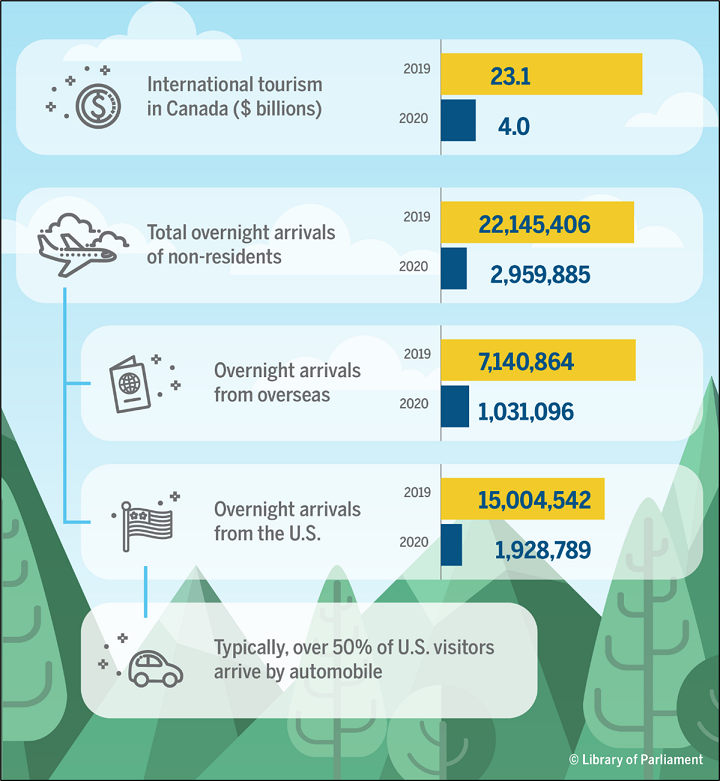
According to Destination Canada, prior to the pandemic, Canada benefited from the fact that the tourism sector was booming globally. Since 2000, tourism has been growing approximately three to four times faster than the global population and about 1.5 times faster than the overall global GDP . Furthermore, notwithstanding the COVID-19 pandemic, this was expected to continue into the mid-2020s. In fact, 2017’s travel and tourism sector growth of 4.6% exceeded the global GDP growth rate of 3.7%; that is, for the seventh successive year, the sector outpaced global GDP growth, which itself had the strongest growth a decade. 3
However, even with this strong performance, Canada’s tourism industry potential remains significantly underdeveloped. Specifically, even though it has outpaced global population and GDP growth, Canadian tourism growth has lagged behind global tourism growth for several years (see section 3.6 of this Hill Study). 4
Moreover, tourism represents a much smaller fraction of Canada’s exports when compared to peer countries such as the U.S., Japan, the United Kingdom and Australia. Studies suggest there is an opportunity for Canada to more than double its international arrivals and associated revenues by 2030. 5 This could be achieved, in part, by capitalizing on “substantial opportunities to increase the number of tourists to Canada from the United Kingdom, China, France, Germany and Australia.” 6
Beyond its role in helping to create revenue and both direct and indirect jobs in the Canadian tourism industry, the efficient promotion of tourism can be seen as a valuable investment in Canada’s overall economy. A 2013 Deloitte study has shown that “a rise in business or leisure travel between countries can be linked to subsequent increases in export volumes to the visitors’ countries.” 7
In 2019, the Canadian tourism sector had its best year on record, reaching 22.1 million international overnight arrivals, a 4.8% increase over the previous year. Similar to other years, the vast majority (67.7%) came from the U.S.; the top three non-U.S. sources of visitors were the U.K. (875,632), China (715,474) and France (668,490). 8
Destination Canada reported that “air and sea arrivals from the Europe region were mostly on par with 2018 levels, with the exception of France, which led the region (+7.0%).” 9 However, there were mixed results from the Asia-Pacific region as the biggest decline came from the region’s largest market, China (-9.1% in air and sea arrivals), with smaller downward trends from Japan (-1.9%) and Australia (-0.4%). More positively, air and sea arrivals from South Korea were slightly ahead of 2018 levels, while India led the region in year-over-year growth (+9.1%). 10
In North America, the U.S. provided an increase in arrivals on overnight trips entering Canada by air and auto of 6.4%. Mexico was the only one of Destination Canada’s long-haul markets to record double-digit year-over-year growth in overnight arrivals by air and sea (12.3%) in 2019. 11
Canada’s rising popularity among Chinese travellers is particularly noteworthy, as China is now Canada’s second-largest overseas tourism source after the U.K. 12 This is partly attributable to Canada’s having been granted Approved Destination Status by the Chinese government. In 2018, Canada welcomed a record 737,000 Chinese tourists, “surpassing the 700K mark for the first time and doubling the number of annual travellers since 2013, with an average annual growth rate of 16%.” 13 Travelling mainly during July and August, “Chinese tourists spend on average about $2,850 per trip to Canada, staying for around 30 nights.” 14
In 2019, Canadians made 37.8 million foreign trips consisting mainly of 27.1 million visits to the U.S. Although travel to the U.S. declined by 2.3% in 2019 compared to 2018, Canadians “spent $21.1 billion on their trips to the United States in 2019, up 4.8% from a year earlier.” 15
Additionally, Canadians made 10.7 million trips to other countries, the most common of which were Mexico (1.8 million), Cuba (964,000), the U.K. (770,000), China (666,000) and Italy (619,000). 16
Canadians also enjoy travelling within the country, making 275 million domestic trips in 2019, down 1.0% from 2018. Spending on trips within Canada declined 0.3% year over year to $45.9 billion. 17 The top locations were Ontario (116.5 million visits), Quebec (56.9 million visits), British Columbia (34.2 million) and Alberta (32.4 million); this includes both intra and inter-provincial/territorial domestic travel. 18
Canada’s Indigenous tourism sector is diverse and comprises different business models. Although its key drivers of employment and GDP come from air transportation and resort casinos, “it is the cultural workers, such as Elders and knowledge keepers, who define many of the authentic Indigenous cultural experiences available to tourists in Canada.” 19 Moreover, when compared with Indigenous tourism enterprises without a cultural focus, those involved in cultural tourism rely more on visitors from foreign markets as part of their customer base.
Prior to the pandemic, Canada’s Indigenous tourism sector had been rapidly outpacing overall Canadian tourism activity. Specifically, the Indigenous tourism sector’s GDP rose 23.2% between 2014 and 2017, reaching $1.7 billion. 20
Lastly, Indigenous tourism businesses cite access to financing as well as marketing support and training as some of the main barriers to growth. 21
Given its proximity and long shared border, the U.S. is by far the biggest source of Canada’s tourism visitors: in 2018, about two-thirds of all foreign visitors were Americans, 57% of whom arrived by automobile. 22 The U.S. is also the most visited foreign destination by Canadians.
U.S. arrivals to Canada reached 14.44 million in 2018, up 1% over 2017 and the highest level recorded since 2004. American tourists like to take advantage of their long weekends for travel, with Memorial Day (the last Monday in May), Independence Day (4 July) and Labour Day (the first Monday in September) contributing to the largest weekend spikes in road arrivals in 2018. 23
Americans spend around $700 per trip to Canada, staying an average of five nights. In 2018, they preferred mainly nature-based activities, including natural attractions, hiking or walking in nature, and viewing wildlife. 24
As shown in Figure 2, analysis of various factors over a 20-year period shows that the number of Americans travelling to Canada relates more to the Canadian/U.S. dollar exchange rate than to changes in the U.S. GDP .
Figure 2 – Index Comparing the Number of U.S. Visits to Canada, the Canadian/U.S. Dollar Exchange Rate and the Change in the U.S. Gross Domestic Product (GDP), 2000–2019 (2000 = 100)
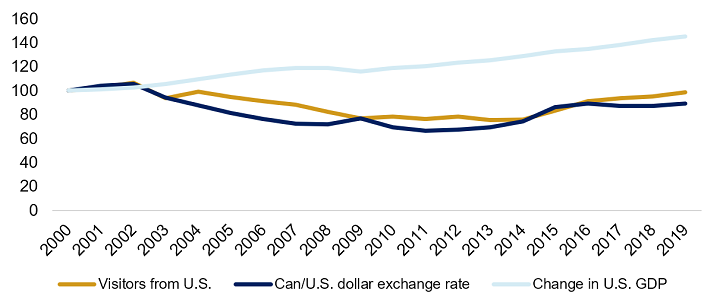
Source: Figure prepared by the Library of Parliament using data obtained from Statistics Canada, “ Chart 1: Tourists to Canada from abroad, annual ,” The Daily , 20 February 2020; Federal Reserve Bank of St. Louis, “ Canadian Dollars to U.S. Dollar Spot Exchange Rate ,” FRED, Database, accessed 20 August 2021; and World Bank, “ GDP (constant 2010 US$) – United States ,” Database, accessed 20 August 2021.
According to the World Economic Forum’s Travel & Tourism Competitiveness Report 2019 , Canada ranked ninth out of 140 countries studied, down from eighth place in 2013. 25 Canada was ranked first in several sub-categories, such as safety and security, environmental sustainability and air transport infrastructure.
In contrast, Canada was found to be deficient in several areas, such as price competitiveness and international openness (e.g., visa requirements, air service agreements).
A 2018 report further indicated the following challenges facing the Canadian tourism sector:
- CONCENTRATED DEMAND – Toronto, Vancouver and Montréal (Canada’s three largest cities) account for 75% of all visitors, and most of this activity takes place during the summer months. Plus, 70% of visitors to Canada come from the U.S., making the sector very vulnerable to the vagaries of the American economy.
- ACCESS – Coming to (and travelling within) Canada can be expensive, difficult and time-consuming; this is true for travel both inter-regionally (e.g., visiting a national park from a large city) and within urban centres.
- LABOUR SHORTAGES – Similar to many sectors that service the public, the tourism industry has been facing labour shortages for some time. In fact, this sector “could face a shortage of 120,000 people by the mid-2020s, and up to 230,000 people by 2030.”
- LACK OF INVESTMENT/PROMOTION – As hotels face up to 95% occupancy during the summer months, there are insufficient room-nights for additional large-attendance events such as conventions, conferences and festivals. Also, compared to peer countries, Canada spends less on marketing and promotion per international tourist arrival (in some cases up to 20% less). One of the contributing factors is that most tourism businesses are small enterprises that face difficulties in securing capital.
- GOVERNANCE – Given that the sector is extremely diverse and made up of many destinations in different regions, successful efforts for one region or operator will not necessarily carry over to other parts of the country or service providers. Also, as tourism policies and programs are spread across numerous organizations within every level of government, making a well-coordinated and integrated Canadian approach is difficult. 26
These assessments suggest that even though Canada is doing well in certain areas, other jurisdictions may be greatly improving their ability to attract international tourism. Changing trends in consumer preferences may also play a role in determining which destinations may be more popular than others at any particular time.
4 The Role of the Federal Government
Destination Canada is a federal Crown corporation responsible for national tourism marketing and is governed by the Canadian Tourism Commission Act . It targets the following markets “where Canada’s tourism brand leads and yields the highest return on investment”: Australia, Canada, China, France, Germany, Japan, Mexico, the U.K. and the U.S. 27
In 2019, the federal government announced its new tourism strategy entitled Creating Middle Class Jobs: A Federal Tourism Growth Strategy . It is based on the following three pillars:
- BUILDING TOURISM IN CANADA’S COMMUNITIES – expand from the concentration of international visitors to Canada’s three largest cities over a few (mostly summer) months by helping communities “exploit and develop the characteristics that make them special. In so doing, they will be better able to convince tourists to get off the beaten path, explore the lesser-known parts of the country, and to visit during the off-peak seasons.”
- ATTRACTING INVESTMENT TO THE VISITOR ECONOMY – to combat the lack of investment in Canada’s tourism sector, the strategy aims to improve coordination among jurisdictions and help attract private investment by establishing “Tourism Investment Groups in every region of Canada to enable the development of impactful tourism projects, including large-scale destination projects.”
- RENEWING THE FOCUS ON PUBLIC–PRIVATE COLLABORATION – with the establishment of the Economic Strategy Table for Tourism, the federal government aims to stimulate and sustain growth in Canada’s tourism sector by working collaboratively with industry to ensure that tourism is on the front lines of economic policy making. This could include addressing “the high cost of travelling to and within Canada, labour shortages and the lack of investment. It could also look at competitiveness, sustainability, the sharing economy and digital platforms.” 28
Part of the focus on improving tourism has been improving accessibility. To that end, in 2018, the Government of Canada introduced Bill C-81, the Accessible Canada Act , which “aims to achieve a barrier-free Canada through the proactive identification, removal, and prevention of barriers to accessibility in all areas under federal jurisdiction, including transportation services such as air and rail.” 29 The bill received Royal Assent in 2019.
4.3 Federal Funding Initiatives
In 2008–2009, the federal government invested over $500 million in the tourism industry to develop facilities and events, and to promote tourism. This is in addition to investments in other areas that affect tourism, such as improvements for Parks Canada and border services. 30 In 2013, funding of $42 million was allocated to improve visa services, 31 an area where Canada has been found to be deficient.
Since 2016, the regional development agencies have allocated over $196 million to tourism businesses, and the Business Development Bank of Canada has provided more than $1.4 billion in financing. Export Development Canada assists Canadian tourism businesses that aim to expand into global markets. 32 Budget 2017 provided Destination Canada with permanent funding of $95.5 million per year for tourism-related work, up from $58 million. 33
Budget 2019 announced that starting in 2019–2020, $58.5 million over two years would go towards the creation of a Canadian Experiences Fund. The Fund supports “Canadian businesses and organizations seeking to create, improve or expand tourism-related infrastructure—such as accommodations or local attractions—or new tourism products or experiences.” These investments would focus on tourism in rural and remote communities, Indigenous tourism, winter tourism, inclusiveness (especially for the LGBTQ2 communities) and farm-to-table/culinary tourism. 34
Additionally, Budget 2019 included $5 million to Destination Canada for a “tourism marketing campaign that will help Canadians to discover lesser-known areas, hidden national gems and new experiences across the country.” 35
Budget 2019 also included the establishment of the Economic Strategy Table dedicated to tourism, which will bring together “government and industry leaders to identify economic opportunities and help guide the Government in its efforts to provide relevant and effective programs for Canada’s innovators.” 36
Announced in Budget 2021, the Tourism Relief Fund is a $500 million national program that is part of a $1 billion package to support the Canadian tourism sector. 37 Its goal is to position Canada as a destination of choice when domestic and international travel is once again deemed safe (i.e., post-pandemic) by:
- empowering tourism businesses to create new or enhance existing tourism experiences and products to attract more local and domestic visitors; and
- helping the sector reposition itself to welcome international visitors by providing the best Canadian tourism experiences to the world. 38
Initiatives under this fund will help tourism businesses and organizations adapt their operations to meet public health requirements; improve their products and services; and position themselves for post-pandemic economic recovery. 39
Part of this funding includes Destination Canada’s $2-million investment along with $950,000 of in-kind support to the Indigenous Tourism Association of Canada to “support the recovery of Indigenous tourism businesses.” 40
Several federal government institutions also play key roles in shaping the outcome of Canada’s tourism economy. For example, the federal government is responsible for the following:
- establishing ticket taxes and travel tariffs;
- providing customs and border services; and
- addressing matters related to national security.
The National Capital Commission and Parks Canada also help ensure that iconic Canadian places are protected and preserved for current and future visitors to enjoy. As well, provincial and territorial governments help develop and promote tourism in Canada.
The Canadian tourism industry was greatly affected by the global COVID-19 pandemic. However, if international borders continue to reopen and if the industry continues its steady overall growth of the recent years prior to the pandemic, tourism will again contribute to Canada’s economic well-being. And although the U.S. continues to be Canada’s biggest tourism trading partner, stakeholders might continue their efforts of focusing on more growth-oriented, lucrative emerging markets to better diversify tourism interests and help Canada fulfil its tourism potential.
- World Travel & Tourism Council, Economic Impact Reports . [ Return to text ]
- Ibid. [ Return to text ]
- Ibid., p. 7. [ Return to text ]
- Destination Canada, China . [ Return to text ]
- Statistics Canada, “ Canadians made fewer trips within Canada and around the world in 2019 ,” The Daily , 9 December 2020. [ Return to text ]
- Ibid., p. 14. [ Return to text ]
- Ibid., p. 15. [ Return to text ]
- Destination Canada, United States . [ Return to text ]
- Destination Canada, Who we are . See also the Canadian Tourism Commission Act , S.C. 2000, c. 28. [ Return to text ]
- Innovation, Science and Economic Development Canada, “ Creating Middle Class Jobs: A Federal Tourism Growth Strategy ,” Creating Middle Class Jobs: A Federal Tourism Growth Strategy . [ Return to text ]
- Ibid.; and Accessible Canada Act , S.C. 2019, C. 10. [ Return to text ]
- Government of Canada, “ Chapter 3.1: Connecting Canadians With Available Jobs –Temporary Resident Program ,” Jobs, Growth and Long-Term Prosperity: Economic Action Plan 2013 , Budget 2013. [ Return to text ]
- Government of Canada, “ Chapter 2: Building a Better Canada – Launching a Federal Strategy on Jobs and Tourism ,” Investing in the Middle Class , Budget 2019. The Government of Canada’s regional development agencies are the Atlantic Canada Opportunities Agency (ACOA); Canada Economic Development for Quebec Regions (CED); Canadian Northern Economic Development Agency (CanNor); Federal Economic Development Agency for Southern Ontario (FedDev Ontario); Federal Economic Development Agency for Northern Ontario (FedNor); Prairies Economic Development Canada (PrairiesCan); and Pacific Economic Development Canada (PacifiCan). [ Return to text ]
- Government of Canada, “ Chapter 2: Building a Better Canada – Launching a Federal Strategy on Jobs and Tourism ,” Investing in the Middle Class , Budget 2019. “LGBTQ2” refers to lesbian, gay, trans, queer and Two-Spirit. [ Return to text ]
- Government of Canada, Tourism Relief Fund . [ Return to text ]
- Destination Canada, Destination Canada providing $2 million in funding to Indigenous Tourism Association of Canada ( ITAC ) . [ Return to text ]
© Library of Parliament
- 44 th Parliament, 1 st Session
- 43 rd Parliament, 2 nd Session
- 43 rd Parliament, 1 st Session
- 42 nd Parliament, 1 st Session
- 41 st Parliament, 2 nd Session
- 41 st Parliament, 1 st Session
- 40 th Parliament, 3 rd Session
- 40 th Parliament, 2 nd Session
- 40 th Parliament, 1 st Session
- 39 th Parliament, 2 nd Session
- 39 th Parliament, 1 st Session
- 38 th Parliament, 1 st Session
- 37 th Parliament, 3 rd Session
- 37 th Parliament, 2 nd Session
- 37 th Parliament, 1 st Session
Related content
- Legislative summaries
- Trade and investment series
- See complete list of research publications
- Publications about Parliament
- Library Catalogue
Travel & Tourism - Canada
- It is predicted that Canada's revenue in the Travel & Tourism market will increase and reach US$17.03bn in 2024.
- Over the next four years, a steady annual growth rate (CAGR 2024-2029) of 2.26% is expected, resulting in a projected market volume of US$19.04bn by 2029.
- The Hotels market is currently the largest market in the country's Travel & Tourism market with a projected market volume of US$7.08bn in 2024.
- By 2029, the number of users is anticipated to increase to 20.25m users.
- It is noteworthy that the user penetration rate is predicted to decline slightly from 63.4% in 2024 to 70.2% by 2029.
- The average revenue per user (ARPU) is expected to be US$0.69k.
- Canada's online sales in the Travel & Tourism market are also projected to witness a significant rise, contributing to 82% of total revenue by 2029.
- In terms of global comparison, Canada's revenue generation is relatively small.
- The United States, for instance, is expected to generate the highest revenue of US$214bn in 2024.
- Canada's Travel & Tourism industry is heavily impacted by the COVID-19 pandemic, resulting in a significant decline in international visitors.
Key regions: Malaysia , Europe , Singapore , Vietnam , United States
Definition:
The Travel & Tourism market encompasses a diverse range of accommodation services catering to the needs and preferences of travelers. This dynamic market includes package holidays, hotel accommodations, private vacation rentals, camping experiences, and cruises.
The market consists of five further markets.
- The Cruises market covers multi-day vacation trips on a cruise ship. The Cruises market encompasses exclusively passenger ticket revenues.
- The Vacation Rentals market comprises of private accommodation bookings which includes private holiday homes and houses as well as short-term rental of private rooms or flats.
- The Hotels market includes stays in hotels and professionally run guest houses.
- The Package Holidays market comprises of travel deals that normally contain travel and accommodation sold for one price, although optional further provisions can be included such as catering and tourist services.
- The Camping market includes bookings at camping sites for pitches using tents, campervans, or trailers. These can be associated with big chains or privately managed campsites.
Additional Information:
The main performance indicators of the Travel & Tourism market are revenues, average revenue per user (ARPU), users and user penetration rates. Additionally, online and offline sales channel shares display the distribution of online and offline bookings. The ARPU refers to the average revenue one user generates per year while the revenue represents the total booking volume. Revenues are generated through both online and offline sales channels and include exclusively B2C revenues and users for the above-mentioned markets. Users represent the aggregated number of guests. Each user is only counted once per year. Additional definitions for each market can be found within the respective market pages.
The booking volume includes all booked travels made by users from the selected region, independent of the departure and arrival. The scope includes domestic and outbound travel.
Prominent players in this sector include online travel agencies (OTAs) like Expedia and Opodo, as well as tour operators such as TUI. Specialized platforms like Hotels.com, Booking.com, and Airbnb facilitate the online booking of hotels and private accommodations, contributing significantly to the market's vibrancy.
For further information on the data displayed, refer to the info button right next to each box.
- Bookings directly via the website of the service provider, travel agencies, online travel agencies (OTAs) or telephone
out-of-scope
- Business trips
- Other forms of trips (e.g. excursions, etc.)
Travel & Tourism
- Vacation Rentals
- Package Holidays
- Analyst Opinion
Canada's Travel & Tourism market is a dynamic sector that continues to evolve with changing consumer preferences and global trends. Customer preferences: Travelers in Canada are increasingly seeking unique and authentic experiences, moving away from traditional tourist hotspots to explore off-the-beaten-path destinations. There is a growing demand for sustainable and eco-friendly travel options, as well as a preference for personalized and customized travel itineraries. Trends in the market: One notable trend in the Canadian Travel & Tourism market is the rise of adventure tourism, with more travelers looking for adrenaline-pumping activities such as hiking, skiing, and wildlife watching. Additionally, the popularity of food and wine tourism is on the rise, as travelers seek out culinary experiences and local delicacies across the country. Local special circumstances: Canada's vast and diverse landscape offers a wide range of attractions for travelers, from the stunning Rocky Mountains in the west to the picturesque coastlines in the east. The country's rich indigenous culture and heritage also play a significant role in shaping the tourism landscape, with many travelers seeking out authentic indigenous experiences. Underlying macroeconomic factors: The stable economy and favorable exchange rate in Canada have contributed to the growth of the Travel & Tourism market, making it an attractive destination for both domestic and international travelers. Government initiatives to promote tourism, along with investments in infrastructure and transportation, have further boosted the sector's growth.
- Methodology
Data coverage:
Modeling approach:
Additional notes:
- Sales Channels
- Travel Behavior
- Destination Shares
- User Demographics
- Global Comparison
- Key Market Indicators
Mon - Fri, 9am - 6pm (EST)
Mon - Fri, 9am - 5pm (SGT)
Mon - Fri, 10:00am - 6:00pm (JST)
Mon - Fri, 9:30am - 5pm (GMT)
- Get immediate access to all Market Insights, reports & statistics
- Download data in multiple formats for collaborative research
- Includes usage & publication rights for sharing data externally
Language selection
- Français fr
WxT Search form
The canadian tourism sector.
From: Innovation, Science and Economic Development Canada

Helping Canadian tourism businesses welcome domestic and international visitors.
The Federal Tourism Growth Strategy
Canada's Federal Tourism Growth Strategy sets a way forward to:
- grow the sector
- attract investment
- increase stability
Innovation, Science and Economic Development Canada launched a Federal Tourism Growth Strategy, which sets a course for growth, investment and stability.

Learn about the strategy
- Read the new strategy
- Learn about the public consultation process

Latest news for tourism businesses
View all news
Subscribe to updates
On this page
Supports and tools for businesses in the tourism sector, spotlight on canadian tourism, destination canada: "a world of opportunity".
- Careers in tourism
Travel and tourism data
Learn more about supports and resources available to help businesses in the tourism sector improve their products and services to welcome Canadian and international visitors.
- Tourism Growth Program
- Indigenous Tourism Fund
- Canada Digital Adoption Program
- Budget 2023: Supporting the Growth of Canada's Tourism Sector
- Past programs
- GC Business Insights newsletter
Don't know where to start? Ask your regional development agency . You'll find targeted advice and support available in your region.
The Indigenous Business Navigator Service groups help from across the Government of Canada all in one place.

Canada Business app
Find government support for businesses.

Business Benefits Finder
Answer a few questions. Get a tailored list of programs and services. Watch your business grow.
Tourism businesses showcasing all that our country has to offer.

Photo location: Carcross, Yukon | Photo credit: Enviro Foto
Indigenous tourism
First Nations, Métis and Inuit people have captivating histories and distinct cultures. Tourists are eager to learn more about them from Indigenous tourism businesses. The Government of Canada is helping through the Indigenous Tourism Fund .

Photo location: Somerset Island, Nunavut
Rural and remote tourism
Canada is one of the largest countries in the world. Many Canadians live in rural and remote areas. It's time to use tourism as an economic driver. This will create good jobs in communities across the country. Learn about the Government of Canada's Economic Development Strategy for rural Canada .

Photo location: Canada
2SLGBTQI+ tourism
Canada is a top destination for 2SLGBTQI+ travellers. Tourism businesses: get inspired! See how destinations across Canada are welcoming this group .

Photo location: Montreal, Quebec
Francophone tourism
Bonjour! Bienvenue! Canada is a key destination for francophones from here and abroad. Find out if you're doing the most to attract this target market .
Destination Canada has a new strategy. This tourism roadmap aims to give Canada a competitive edge on the global stage. Read " A World of Opportunity ."

Photo location: Saint Malo, Manitoba
Careers in Tourism
Considering a career in a very inclusive sector with jobs across the country? Opportunities abound to shape the future of tourism in Canada.
Visit Tourism HR Canada to learn more.

Photo location: Nahanni River, Northwest Territories
The Canadian Tourism Data Collective went live in May 2024. It provides real-time insights, data and analytics. This in turn will fuel the growth of Canadian tourism.
Visit the Statistics Canada website to find important data about travel and tourism in Canada.
Interested in gaining insight on small and medium-sized enterprises in the sector? Read the SME Profile: Tourism Industries in Canada, 2020 report.

The Honourable Soraya Martinez Ferrada Minister of Tourism
A message to Canada's tourism business owners and operators:
"Canada is a tourism superpower. We have what the world wants, from majestic mountains to dynamic downtowns.
"What you do is much more than a job: you are ambassadors for Canada. You are often the first Canadian that a foreign tourist meets when they arrive and the last one they see before heading home."
Read the full ministerial message.
Did you find what you were looking for?
If not, tell us why:
You will not receive a reply. Telephone numbers and email addresses will be removed. Maximum 300 characters
Thank you for your feedback
Canadian Business Travel is Forecast to Return to Pre-Pandemic Levels in 2024, Reaching $25.9 Billion USD and 13.5% Annual Growth
GBTA’s Canada Conference spotlights the resurgence in business travel spending, evolving industry trends, recognition of association volunteers and introduction of new regional leaders
Business travel in Canada is poised for a strong, evolving future, according to the takeaways and forecasts unveiled during the Global Business Travel Association (GBTA) Canada Conference 2024 held in Toronto this week, April 22-24. As the premier trade association and “voice” of the global business travel industry, GBTA welcomed business travel professionals, companies and guests from across Canada and beyond to the Beanfield Centre for its 20th annual regional event.
Over 600 registered business travel buyers, suppliers and other attendees, including over 50 exhibiting companies, came together for main stage presentations, panel conversations and education sessions. The event also included recognition of GBTA’s Canadian volunteers and the conference’s legendary “Big Night Out” networking event. Strong Forecast and Outlook for Business Travel in Canada An eagerly anticipated aspect of the Conference, GBTA released the Canada-specific forecast from its Business Travel Index™ (BTI) Outlook report along with other research highlights, insights and trends ahead for the industry. According to data from the latest GBTA BTI report, business travel spending in Canada is expected to recover to its pre-COVID level this year, which is one year later than the broader North American region but parallel to the global rate of recovery.
For 2024, GBTA forecasts indicate Canadian business travel spending is anticipated to reach $25.9 billion USD, representing annual growth of 13.5%. This outpaces both global (11.8%) and United States (9.2%) growth forecasts. In 2019 before the pandemic, Canadian business travel had reached $25.7 billion USD.
Other key GBTA research takeaways for the Canada business travel sector included:
- Canadian travel buyers expect to spend more on business travel in 2024, with nearly three in five (59%) planning for their companies’ spend to be higher compared to last year.
- Nearly two-thirds (65%) of Canadian travel buyers expect their company will take more business trips this year compared to last year , but two in five (18%) expect the same volume of business trips.
- When asked about challenges, Canadian buyers and suppliers cited financial concerns at the top of their list, namely the rising cost of travel, overall economic conditions and corporate budgets not keeping pace with needs.
- In the 2023 GBTA BTI’s worldwide survey of business travelers, 57% of Canadian business travelers who responded say they traveled the same amount or more than they did pre-pandemic.
- 55% said they blended travel (i.e. combining leisure travel with their business trips) more than they did in 2019.
- They reported spending an average of $884 USD per business trip in 2023.
- 82% said business travel is worthwhile in achieving their business objectives.
New National and Regional GBTA Leadership Takes the Stage
Janette Acosta Sanchez, who joined GBTA in February as Country Director for Canada, took the conference’s main stage for the first time, leading key sessions and reiterating the organization’s commitment to educate, communicate and advocate for a thriving post-pandemic Canadian business travel industry.
“Canada is a truly diverse country, marked by a variety of cultures, mindsets and priorities. There are no ‘one size fits all’ solutions and GBTA is squarely focused on creating a sustainable, successful future for the Canadian business travel industry. A strong business travel industry is essential to the region, from ensuring our future workforce to making Canada one of the top economies for global business travel,” said Sanchez.
Along with Acosta Sanchez and an esteemed group of presenters, panelists and guests, Cristina Scott, GBTA Senior Vice President for the Americas, also addressed the conference’s attendees for the first time since joining GBTA in August 2023.
“One of GBTA’s pillars is uniting the business travel community, and we recognize Canada has a unique travel market, filled with diversity in its people and priorities. With so much going on in our industry right now as we continue to discover what a post-pandemic business travel sector looks like, we are committed to making sure Canada’s voice is heard while we look ahead and navigate the future of business travel together,” said Scott.
Conference Celebrates a Milestone, Recognizes Volunteers and Delivers Actionable Education and Takeaways
GBTA Board of Directors President, Mark Cuschieri, opened the conference by noting 2024 marks 20 years GBTA has held a Canada Conference.
GBTA’s head of Government Relations and Community Affairs, Shane Downey, discussed the association’s advocacy priorities and actions taken globally and in Canada. He also led a discussion with expert panelists on how the travel industry is responding to government initiatives and seeking solutions. Additionally, a main stage fireside chat on the country’s accessibility standards included Canadian government officials.
GBTA again recognized outstanding volunteers in Canada for their contributions. Award recipients are:
- GBTA Volunteer Inspiration Award : Patrick Doyle, Chief Commercial Officer for Flight Claim
- Business Travel Service Award winners for Canada : Jennifer Urquhart, Director, Strategic Sales at Enterprise Mobility, and Charles Crowder, Head of Global Airline Relationships at ARC Corporation
Education sessions focused on critical priorities and opportunities in the Canadian business travel sector including travel manager needs of the future; traveler evolution and the passenger journey; embracing Artificial Intelligence (AI) and other technologies; the continuing roll-out of New Distribution Capability (NDC); and sustainability in business travel. The event also included numerous buyer and supplier sessions, networking opportunities, and a special welcome event for new and returning industry professionals. The Canada Conference’s concluding main stage was an “Ask Me Anything” session with supplier and buyer panelists who answered questions about various topics related to the Canadian business travel landscape.
GBTA also announced it will host its 21 st Canada Conference again at the Beanfield Centre in Toronto April 28-30, 2025.
To view photos from the GBTA Canada Conference-Toronto, visit the event gallery here . Interviews about the latest developments from industry leaders at the conference’s Broadcast Studio will be uploaded to GBTA’s YouTube channel in the next few days.
- GBTA Convention 2024
- GBTA On Demand
- Member Dashboard
- Member Directory
- GBTA Leadership
- US Chapters
- Sustainability
- Industry Job Openings
- Sponsor & Exhibit
- Past Events
- Global Equity Program
- GBTA Committees
- GBTA Chapters
- GBTA Ladders
- Member & Networking
Tour Operators
Destinations.
- Hotels & Resorts
- Digital Edition Spring 2024
- Digital Edition Fall 2023
- Travel Webcast
- Voices of Travel
- Agents' Choice Gala
- Agents' Choice survey results
- Canadian Travel Press
- Travel Courier
- Agents' Choice 2023
- Agents' Choice 2022
- Offshore Travel Magazine
- Culinary Travels
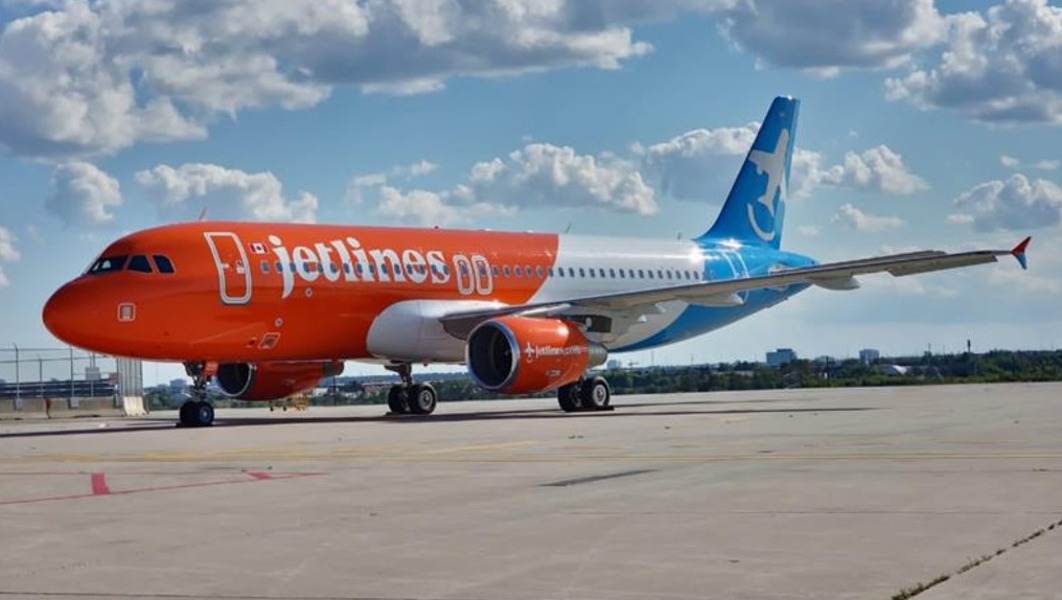
TICO issues closure advisory for Canada Jetlines & Canada Jetlines Vacations
TICO has provided an update for customers who booked travel with Canada Jetlines and Canada Jetlines Vacations. Canada Jetlines ceased operations on Aug. 15, 2024 and was declared bankrupt on Sept. 11, 2024. Canada Jetlines Vacations, a TICO-registered travel retailer and tour operator, terminated its TICO registrations on Sept.11, 2024. For...
Four Seasons introduces new ultra-luxe private jet itinerary
Acv offering free connecting flights for 7 sandals resorts, rit vacations introduces exciting new tours for 2025, windstar expands in the south pacific with shorter itineraries, air france to serve 170 destinations for winter 2024/2025, exodus adventure travels partners with priority pass.

Leading luxury hospitality company Four Seasons is once again setting the standard in...

From now through Oct. 11, 2024, all new ACV bookings made to any of the seven Sandals Resorts or...
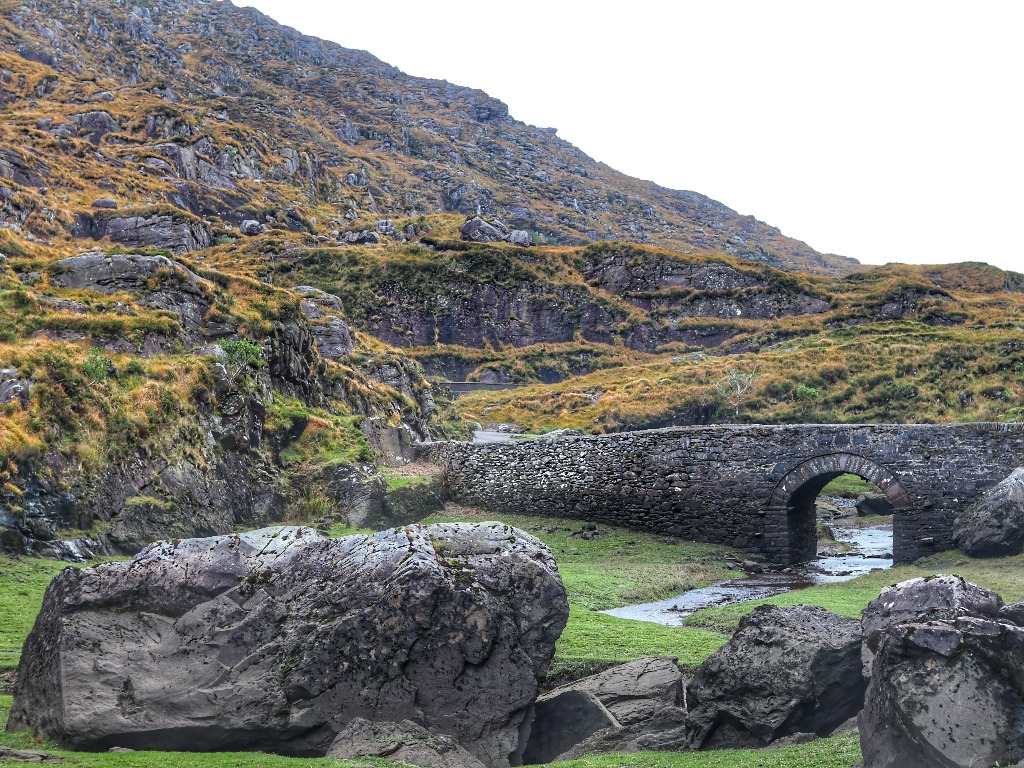
Celebrating 24 years of excellence, RIT Vacations has released its 2025 travel...

Windstar is significantly expanding its itineraries for the line in the South Pacific: the only...
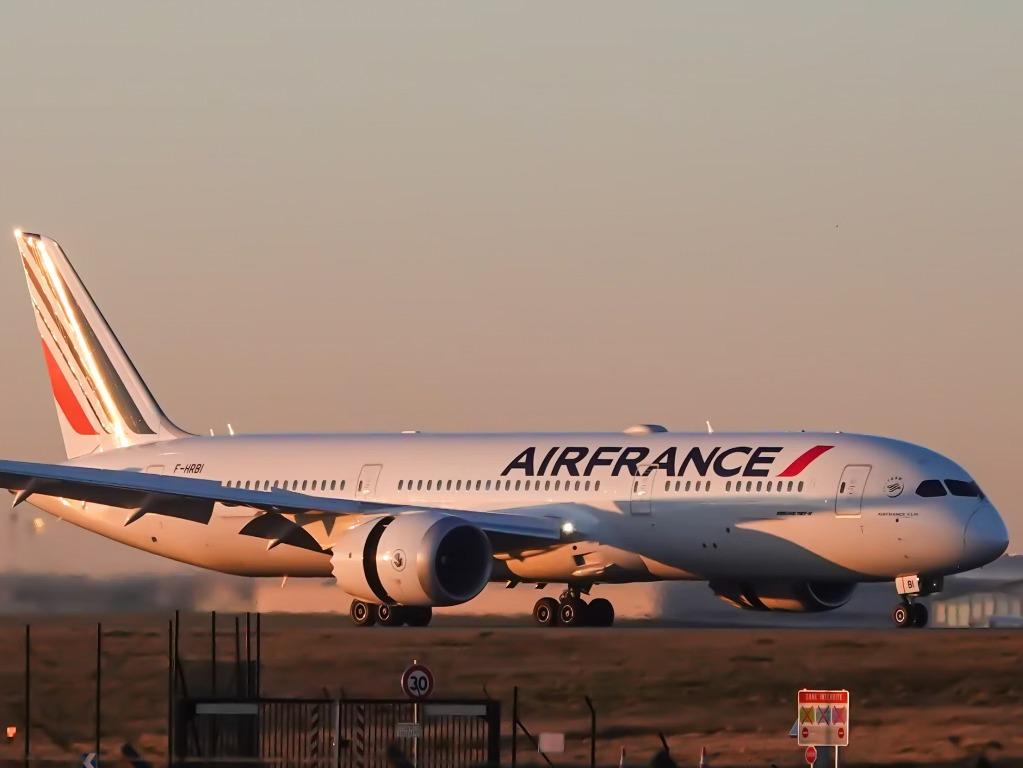
During the 2024-2025 winter season (running from November 2024 to March 2025), Air France will...
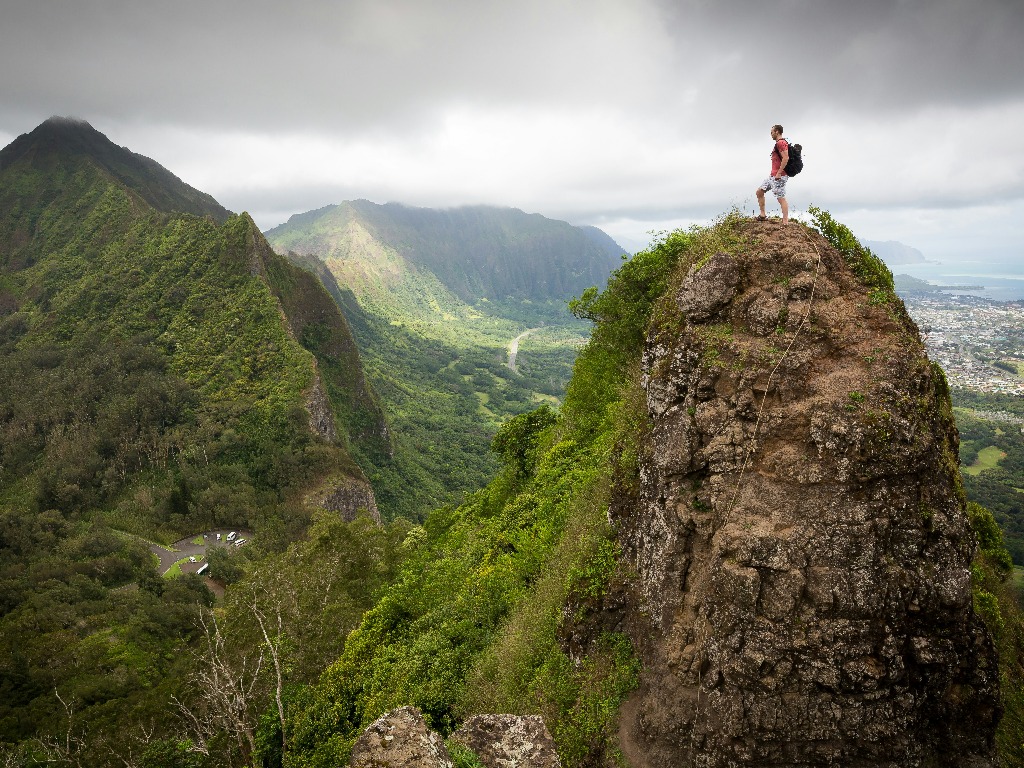
Exodus Adventure Travels has formed an agreement with Priority Pass™, the world's original...
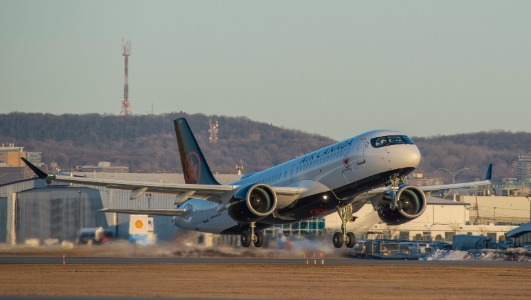
UPDATED: Industry Relieved as Air Canada, ALPA reach tentative deal
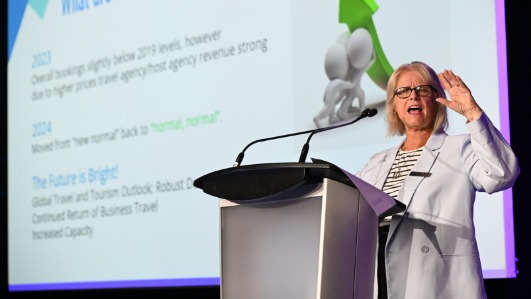
ACTA urges Air Canada, pilots to negotiate and ‘come to a resolution’
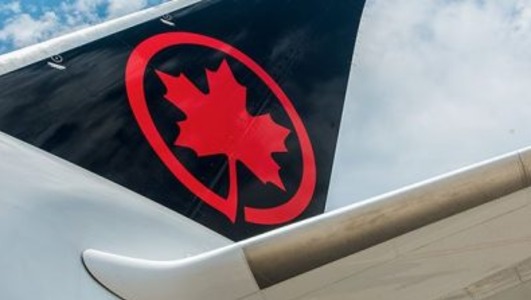
Air Canada urges federal government to direct arbitration to avert disruption
TICO has provided an update for customers who booked travel with Canada Jetlines and Canada Jetlines Vacations. Canada Jetlines ceased operations on Aug. 15, 2024 and...

Goway launches new Nordic product line with 14 itineraries
Leading luxury hospitality company Four Seasons is once again setting the standard in experiential travel with the introduction of a new itinerary, Grand Horizons, as...
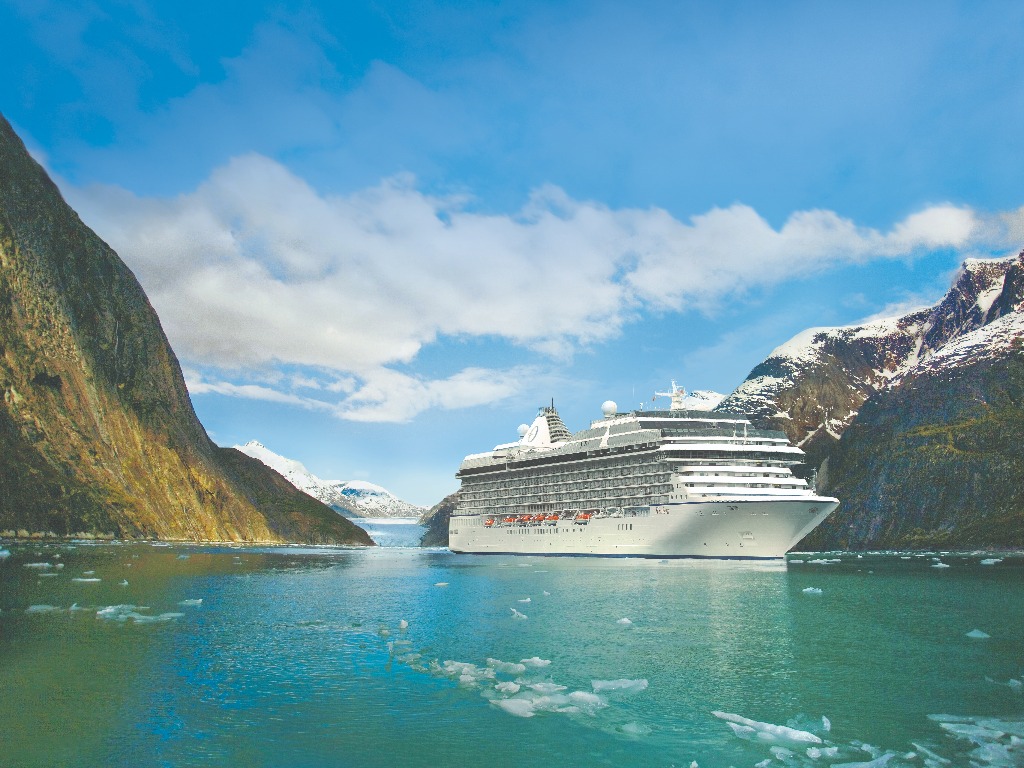
Oceania Riviera to sail Alaska in 2025

Trinidad and Tobago’s food and music festival in T.O. saw record crowds

Los Cabos is getting more direct flights from Canada this fall/winter

Visit Orlando brings Sunshine Tour to Ottawa, Montreal
Windstar is significantly expanding its itineraries for the line in the South Pacific: the only region other than the Mediterranean where Windstar sails...

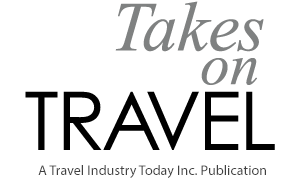
Travel Industry Today
Friday, 20 September 2024

YOU WANT TO COMPLAIN? CTA considers a new plan for ticked travellers
A new proposal from the country's transport regulator would charge airlines $790 for each passenger complain it resolves – regardless of which party wins the dispute. The Canadian Transportation Agency (CTA) has launched a one-month consultation on the proposed reforms, which would apply to valid customer complaints processed and settled by the regulator. MORE

HOW TO RECOUP COSTS WHEN TRAVELLING TO AN EVENT THAT GETS CANCELLED
Ariella Kimmel and Mandi Johnson were grabbing a bite to eat in Vienna, when their August trip to the Austrian capital was upended. The Canadian duo had travelled to the city to see Taylor Swift in concert only to learn her shows would be cancelled because of two men plotting to launch an attack on fans outside the venue, Ernst Happel Stadium. MORE

CATSA UPGRADE SPEEDS SECURITY LINES
At YVR, removing laptops and liquids from your carry-on at security is a thing of the past, thanks to a fresh use of half-century-old technology. Vancouver is the first flight hub in the country to deploy CT scanners in a bid to detect explosives and other threats, according to CATSA. And the agency plans to install the technology, which provides 360-degree views via computerized X-ray imaging, at airport checkpoints across the country in the coming years. MORE

EAST OR WEST? 5 FACTORS TO WEIGH IN PLANNING A CARIBBEAN CRUISE
As you start planning your dream cold weather getaway, the first question to ask is where are you headed? It may not clear as you scan cruise websites, but there are two main routes around the Caribbean: Eastern and Western. They go back to the days of sailing ships and originally developed because of the trade winds and the ease of hopping between islands. MORE

CHERISHED LOUISBOURG LIGHTHOUSE SHINES ON
To mark its 100th anniversary this year, the Louisbourg Lighthouse, which stands at the same location as the first lighthouse in Canada originally built in Cape Breton in 1734, has revealed a full refurbishment designed to help the historic structure on for another century MORE

LISTENING IN New musical takes audiences on a ‘Joyride’ with Roxette
Furthering the ‘90s musical revival, Malmö Opera in Sweden is hosting ‘Joyride the Musical,’ a new feel-good production paying tribute to the music of Swedish pop band Roxette. The musical takes audiences on a joyful, humorous journey that since its debut Sept. 6 has received rave reviews from audiences, comprised in large part by international visitors. MORE

CHECK OUT OUR SPECIAL INFOCUS EDITIONS:

JUST IN CASE YOU MISSED YESTERDAY’s STORIES:

FRUSTRATION IN THE RANKS Could pilots reject Air Canada deal?
Low entry-level pay in the tentative deal between Air Canada and its pilots could be a stumbling block ahead of a union vote on the agreement, some aviators and experts say. While the tentative agreement's cumulative 42 percent wage hike over four years applies to all flight crew – a big topline gain after a decade of two per cent annual raises – many could still feel left out of the windfall. MORE

TICO LISTS CLAIMS PROTOCOLS FOR CANADA JETLINES
The Travel Industry Council of Ontario has posted a closure advisory, including claims protocols, for Canada Jetlines, which ceased operations on Aug. 15, and was declared bankrupt on Sept. 11, 2024. On the same date, Canada Jetlines Vacations terminated its TICO registrations. MORE

RIU ‘AMPLIFIES’ ITS MESSAGE TO CANADA
On a day that was “all about RIU,” close to 125 senior managers and executives from across the Sunwing Travel Group convened Tuesday with RIU Hotels & Resorts execs to learn the latest from one of the Canadian travel company’s most important partners. MORE

GOWAY’S NORTHERN LIGHTS SHINE BRIGHT
Goway has reinvigorated its product line to Northern Europe with the introduction of 14 new itineraries across Denmark, Finland, Norway, and Sweden. The tour company says its new tours showcase the depth of experiences available in the Nordic nations, from beautiful city centres to magnificent natural settings, including the fjords and the Arctic Circle. MORE

UNDER PRESSURE Pax suffer bleeding ears, noses on Delta flight
The US Federal Aviation Administration is investigating after a Delta Air Lines flight with cabin pressure issues left some passengers with bleeding eardrums, headaches and bloody noses. The flight was travelling Sunday from Salt Lake City to Portland, Oregon, when pilots of the five-year-old Boeing 737-900ER aircraft noticed a pressurization problem and made an emergency landing back in Utah's capital, according to the flight log. MORE

WALT DISNEY WORLD New vacation club option opens at Polynesian resort
Disney Vacation Club will begin offering a new opportunity to call Disney’s Polynesian Villas & Bungalows “home” with the addition of the new Island Tower, opening in Orlando on Dec. 17. Sales will open to current Disney Vacation Club members on Oct. 1 and the public on Oct. 29. MORE
Begin typing your search above and press return to search. Press Esc to cancel.
Travel Industry Statistics in Canada
- Updated: June 11, 2024
- Canadian Statistics
Canada is a popular tourist destination with visitors from all over the world coming to see its stunning natural landscapes, vibrant cities, and the Northern Lights among many other attractions. Each year, Canada’s travel industry makes a significant contribution to the country’s economy. However, the COVID-19 pandemic stopped all tourism and the travel industry was one of the worst affected industries.
In this article, we explore the travel industry in Canada through statistics including how it has recovered since the pandemic and what its future might look like.
Travel Industry Statistics for Canadians
- It is estimated that by the end of 2023, the Canadian travel industry will employ 1.64 million people.
- In 2022, the contribution of the travel industry to the Canadian economy grew by 41.4% compared to 2021.
- In June 2023, the number of visitors to Canada was 83% of the number in June 2019, showing strong signs of recovery.
- There were 699,900 trips to Canada by residents from overseas countries and 2.6 million trips by US residents in June 2023.
- In June 2023, over 3 million Canadians travelled abroad, either to the United States or overseas.
- In the first quarter of 2023, spending by domestic tourists was up, while spending from non-resident tourists was slightly down.
- Cruise holidays are a fast-growing sector of the travel industry, with the number of trips almost 40% higher in June 2023 than the same month before the pandemic.
- In 2022, almost 80% of holidays were booked online in Canada.
- The travel industry’s workforce is young with over 30% of employees being between 15 and 24 years old.
- At the end of the first quarter of 2023, 126,345 jobs remained unfilled in the travel industry.
- The Canadian travel industry is expected to have recovered fully from the pandemic by 2026.
Travel Industry in Canada
The Canadian travel industry is showing strong signs of recovery from the COVID-19 pandemic. It is now on target to contribute over $162 billion to the economy of Canada in 2023.
Data from the World Travel & Tourism Council shows that the travel industry in Canada is close to the pre-pandemic peak of 2019 when it contributed $173.9 billion to the economy. The contribution of the travel industry in Canada grew by 41.4% in 2022, when it reached over $138 billion. That represents 5% of Canada’s economy or one dollar in every $20 being generated by the Canadian travel industry.
International Travel
In 2022, the spending by international travellers to Canada grew by 64% and reached almost $23 billion. Despite the impressive growth, the figure was still 47% lower than before the pandemic when spending by international travellers was the highest ever at $42.9 billion.
According to Statistics Canada, in June 2023, the number of returning Canadian residents and non-resident visitors to Canada was getting closer to pre-pandemic levels. The total number of visitors and returning travellers was 83% of the June 2019 figure.
Overseas Visitors to Canada
In June 2023, there were 699,900 trips to Canada by residents from overseas countries. This was 78.7% of the number of arrivals from overseas in June 2019. Compared to the previous June, the number of overseas visitors was 50.8% higher.
The number of visitors from European countries was up by 24.4% from 224,700 in June 2022 to 304,300 in June 2023. It was 80.4% of the number of visits in June 2019. The number of visitors from Asia more than doubled from 99,000 in June 2022 to 206,900 in June 2023. This was 69% of the pre-pandemic figure. The lower recovery percentage shows that travel from Asia has been slower to recover.
Visitors from the United States
The residents of the United States took 2.6 million trips to Canada in June 2023. This was 52.6% higher than the number of visitors in the previous June when there were 1.7 million trips from the US to Canada. The June 2023 figure represented 87,8% of the pre-pandemic numbers.
The arrivals by land increased by 61.3% from 1 million to 1.7 million. The majority of these trips were taken by automobiles at 1.6 million, while 48,200 were by bus, 23,700 by train, and 22,700 by cyclists or pedestrians. 42.3% of visits by automobile were one-day trips.
Canadians Travelling Abroad
Since the restrictions put in place during the COVID-19 pandemic have been lifted, Canadians have returned to travelling abroad. In 2023, there was a 34.4% increase in the number of trips Canadians were taking abroad. In total, 3.4 million Canadian residents returned home after trips abroad in June 2023.
Trips to Overseas Destinations
The number of overseas trips made by Canadians was up from 571,700 in June 2022 to 653,100 in June 2023. This represents a 14.3% increase in a year and 83.7% of the trips taken in June 2019.
Trips to the United States by Canadians
In June 2023, Canadians made 2.8 million trips across the border to the United States. This was an increase of 40.2% compared to June 2022, when Canadians made 2 million trips to the US. Compared to pre-pandemic levels, it was 79.8% of the trips completed in June 2019.
At 2 million, the vast majority of the trips to the US were by automobile and 66.7% of these trips were one-day trips. There were 645,200 trips by air, which represents a 43.9% increase compared to June 2022. It was also 1% higher than in June 2019.
Tourism Spending in Canada
During the first quarter of 2023, the domestic tourism spending in Canada was $15.6 billion, representing a 3.5% increase. Food and beverage services grew by 6.1%, air transport by 4.6%, and accommodation services by 4.4%. Compared to pre-pandemic spending, domestic spending was 86.7% of the spending in the final quarter of 2019.
After increases in spending by international visitors in the last three quarters of 2022, the spending was down slightly, by 0.1% in the first quarter of 2023. Overnight trips by non-residents decreased by 0.4% but same-day trips increased by 10.5%. The largest decline was in spending on passenger air transport at 3.2%.
Cruise Trips Are Popular in Canada
Cruise ship holidays are a fast-growing holiday type in Canada. In June 2023, Canadians took 21,000 cruise trips, representing a 39.7% increase compared to June 2019.
During the same month, there were 271,900 cruise trips taken by US residents and 32,300 by overseas residents. The number of cruise trips by US residents was 30.1% higher than in June 2019. The number of cruises taken by overseas residents did not yet reach pre-pandemic levels, representing 81.7% of June 2019 trips.
Canadians Book Most of Their Holidays Online
For several years now, Canadians have booked the majority of their holidays online. According to Statista, in 2017, Canadians booked 29% of their holidays offline and 71% online. By 2022, only 24% were booked offline and 76% online. If the same change rate continues, by 2027, only around 18% of holidays will be booked offline, while 82% will be online bookings.
Working in the Travel Industry
In 2022, the travel industry created 169,000 more jobs than it did the year before, increasing the number of jobs in the industry to 1.55 million. That represented one out of every thirteen jobs in Canada. During the pandemic, the sector lost 283,500 jobs but had recovered 124,000 of them by the end of 2022.
It is predicted that by the end of 2023, the industry will have created around 90,000 new jobs. This will increase the number of people working in the travel industry in Canada to 1.64 million. Should this happen, it would mean that almost all the jobs lost because of the pandemic would have been recovered.
While the travel industry is an important employment sector in Canada, many of the employees in the sector are young. The Canadian census from 2016 showed that 31% of the travel industry workforce was aged between 15 and 24. The same age group represents just 13% of the overall labour force in Canada.
The travel industry is also an important source of employment for immigrants to Canada. According to the 2016 census, 28% of the industry’s employees were non-permanent residents or recent immigrants.
The biggest employer within the industry is food and beverage services, which employed approximately 838,000 people in 2022. It is followed by recreation and entertainment with 508,600 employees and transportation with 267,300 employees.
Employee Shortages
While the increase in travel has created new jobs within the travel industry, many of these jobs remain unfilled. According to Destination Canada, at the end of the first quarter of 2023, there were 126,345 unfilled jobs in the travel and tourism industry. This represents 6.8% of the jobs.
There are several reasons for the shortages, some of which are a result of COVID-19-related changes. For example, many younger workers returned to studying during the pandemic or shifted from full-time to part-time work. The pandemic also prompted many older employees in the industry to retire early.
These changes have coincided with changing demographics in Canada, such as a slower birth rate and an ageing population.
Travel Industry Predictions in Canada
It is predicted that Canada’s travel industry will continue to grow and will contribute around $238 billion to Canada’s GDP over the next ten years. This would represent 7% of the overall economy of Canada.
Domestic tourism spending is expected to recover to pre-pandemic levels by the end of 2023. Spending by tourists from the United States is expected to recover next and be back to or overtake 2019 levels in 2023 while spending by overseas travellers is expected to recover fully in 2025. In terms adjusted to inflation, the overall tourism spending will recover fully by 2026.
As the travel industry continues to grow, it will create more new jobs. It is estimated that by 2033, around 2.1 million Canadians will work in the travel industry. This would mean that one out of every eleven jobs in Canada is within the travel and tourism industry.
When the COVID-19 pandemic hit in early 2020, the travel industry was one of the worst affected industries with both international and domestic travel prohibited. It has taken a while to recover but is now showing good signs of recovery with both domestic and international trip numbers getting closer to pre-pandemic figures.
Domestic travel is expected to be the first to recover fully, followed by trips by US residents, and then the rest of the world. As the industry continues to recover, it has created more employment opportunities for Canadians. However, the industry is still facing staff shortages following the pandemic.
Frequently Asked Questions
Is canada a popular tourist destination.
Canada is a popular tourist destination and before the COVID-19 pandemic, the number of people travelling to Canada was increasing every year. The tourist industry is now showing very strong signs of recovery and it is expected that the numbers will be back to pre-pandemic levels, or overtake them by 2025.
Where do most of the international tourists in Canada come from?
The vast majority of trips to Canada are by residents of the United States. In June 2023, there were 2.6 million visits to Canada by US residents and 699,900 by overseas residents.
How many people does the travel industry employ?
The travel industry employs approximately 1.55 million people in Canada. It is predicted that there will be 90,000 new jobs created in the industry during 2023, taking the total number of jobs to approximately 1.64 million.
TravelPulse
Statistics Canada
Statistics Canada – Key Indicators
Destination Canada
Tourism HR Canada
Government of Canada
As Canadians, we grew tired of the tariff battles with the US and unfair practices of other partners. In July 2018, we decided to do something about it, starting to compile a list of products and services available in Canada so you can rest easy knowing your dollars are having their maximum impact in the Canadian economy.
18 King Street East, Suite 1400 Toronto, Ontario, M5C 1C4 Canada
Mon – Sun: 9:30am – 5pm
+1-647-360-8033
Visiting Canada and Canadian Tourism
Over 18 million foreigners visit Canada every year making tourism an over $80 billion-a-year Canadian industry — bigger than lumber, fishing, and farming combined. So why not join in?

The Government of Canada spends a lot of effort promoting Canadian tourism through a variety of websites and social media accounts, including Instagram — as seen here. The current slogan is "Canada: Keep Exploring" with "explorecanada" their most widely used user name and hashtag.
Why come to Canada?
Canada is a large, diverse country with a lot going for it, but most tourists are drawn to a few of the same things:
Nature — Canada is one of the most beautiful countries in the world, full of picturesque forests, mountains, and lakes that make it a fantastic place for camping, hiking, or just wandering around and admiring.
Winter Sports — Canada’s snowy climate and mountainous geography has produced no shortage of must-visit parks and resorts for anyone interested in skiing, snowboarding, snowshoeing, or any other activity best enjoyed in the cold.
Cities — Canada is home to several large, modern cities that anyone with a taste for urban life will be able to appreciate.
Cost — The Canadian dollar is generally quite weak in comparison to other currencies, which make it a very affordable option for people without too much money in their travel budgets.
- Bank of Canada Exchange Rates
The rest of this chapter deals with general information about traveling to Canada. For more information on things to see and do in Canada’s four most popular tourist destinations, please see the specific chapters on British Columbia tourism , Alberta tourism , Ontario tourism , and Quebec tourism .
What language do they speak in Canada?
Foreigners are sometimes confused by Canada’s language situation. Officially, Canada has two official languages , French and English. However, this is mostly just a matter of government policy. The vast majority of Canadians only speak English, and lack even basic skills in French. French-speaking tourists should not expect to speak French in cities like Vancouver, Toronto, or Calgary.
The capital city of Ottawa is more functionally bilingual than most Canadian cities, and all museums and government-related attractions will feature signs and brochures in both French and English. Staff at popular attractions will likely be fluently bilingual as well, as will many employees of popular stores and restaurants. It helps to ask, however.
The famous city of Montreal , in the province of Quebec , is the most bilingual city in Canada and most residents, particularly those who live and work in the downtown core, can speak fluent French and English. It is not considered controversial in Montreal to speak either French or English to a stranger and assume the other person will understand. In other parts of Quebec, however, rates of English fluency are much lower and it may be considered offensive to speak English to a stranger without first asking for permission.
Downsides of Canada
To avoid unhappy surprises, would-be tourists to Canada should be aware of the following potential disappointments before they go:
Bad weather — Unless you are specifically traveling to enjoy winter activities (see above), there are generally only a few months of the year (usually around June to September) in which Canada’s weather will be mild enough to enjoy. Canadian winters, and even parts of spring and fall, are often cold, dark, snowy, and wet, which can make tourist activities difficult or unpleasant.
Long travel distances — Canada is an enormous country and its main cities are all spread quite far apart from each other. Tourists, particularly European tourists unfamiliar with the vastness of North America, are sometimes disappointed to learn that they will probably only be able to see a rather small part of Canada on their trip. Visiting multiple major Canadian cities on a single vacation — for example, Vancouver, Toronto, and Montreal — would be extremely time-consuming and likely cost thousands of dollars in domestic travel alone.
“America Jr.” — Some tourists are disappointed to discover that Canada is extremely similar to the United States . Travelers familiar with America should not expect to encounter a strikingly different culture in Canada. Stores, brands, food, entertainment and so on will be overwhelmingly American. Though the international press likes to emphasize Canada as being a more “liberal” country than the US, Canadians will probably not seem very different from Americans in day-to-day encounters.
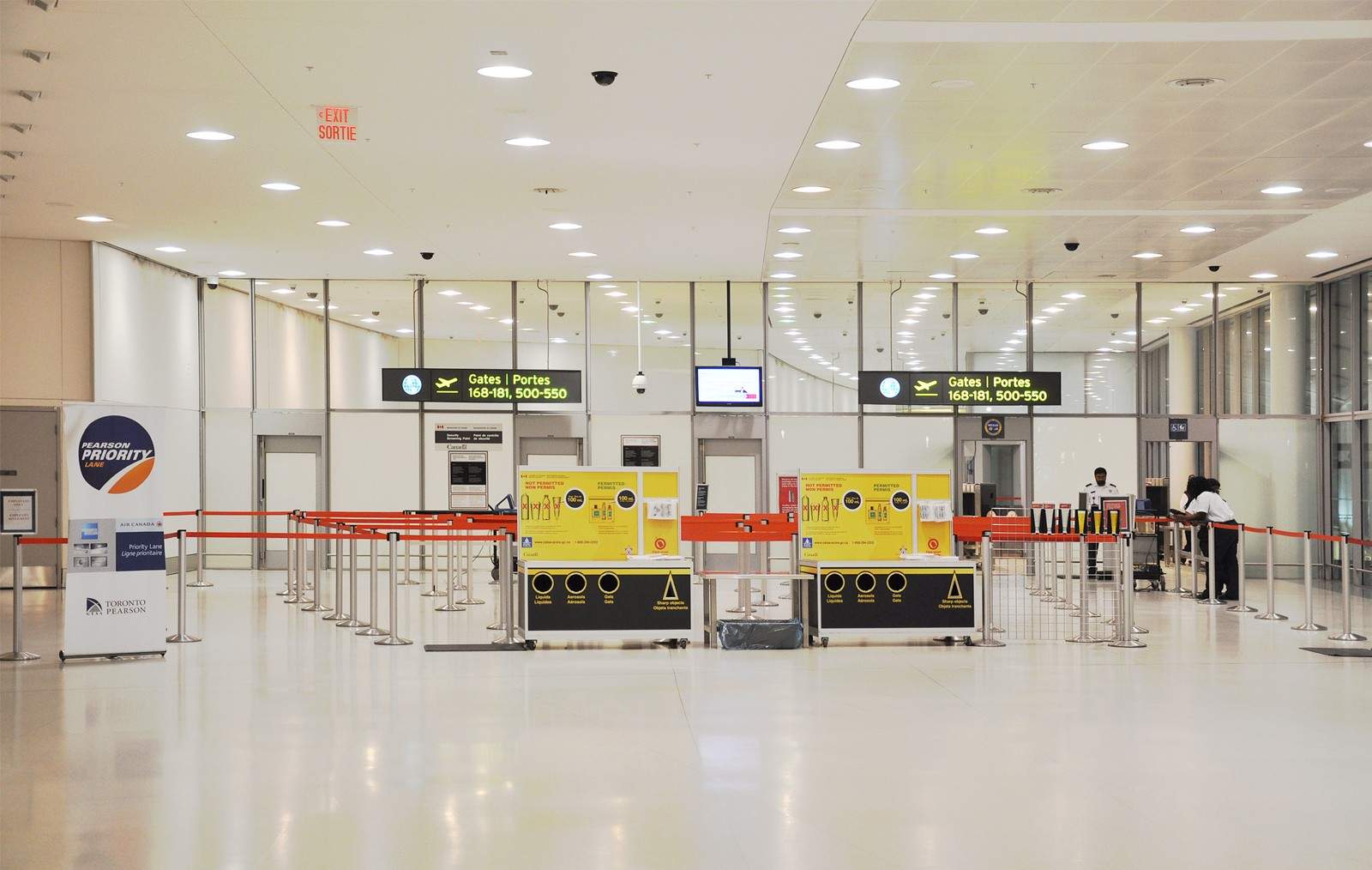
Security checkpoint at Toronto's Pearson International Airport. Serjio74/Shutterstock
Sick travelers.
Travelers from certain countries will need to be cleared by a medical exam as part of their application process before they can visit Canada. During times when there's a global panic over the spread of a particular infectious disease, such as the SARS scare of 2003 or the Ebola scare of 2014, visitors who display worrying symptoms may be detained by border authorities and sent to a hospital for quarantining.
How to Visit Canada
Customs and visas.
Canada does not treat all international visitors the same; citizens of certain countries will have an easier time entering Canada than others. All foreign visitors to Canada, however, must bring a valid passport from their home country.
Residents of the United States have the easiest entry to Canada, and don’t require anything other than a passport to get in. Residents of Great Britain, western Europe, and a few other countries have to obtain an Electronic Travel Authorization ( ETA ) before they can enter. This is a very easy process that only takes a couple of minutes and should be done online before you leave. Once completed, an ETA lasts for five years or until you get a new passport.
- Find out if you need an Electronic Travel Authorization (eTA) or a visitor visa
Residents of countries not covered by the ETA program can only visit Canada after obtaining a short-term visitor’s visa . Applications can be done online, through the mail, or at an overseas Canadian consulate. They take a couple weeks to process and usually cost around $200. For more information, see the Government of Canada’s visitor eligibility questionnaire .
It is illegal for anyone, from any country, to enter Canada to work or live without first obtaining a long-term visa , which are much more complicated to apply for, and take many months to be approved.
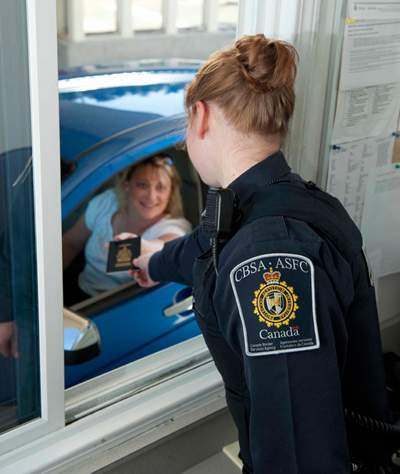
Canada's land border crossing stations operate as drive-throughs. Visitors who arrive by air cross the border at the Canadian airport.
Crossing the Canadian Border
Anyone entering Canada from a foreign country by land, sea, or air — including Canadians themselves — are required to have an interview with a Canadian border guard at their point of entry so it can be determined they are a safe and legal visitor. Exactly how long and invasive this interview will be depends very much on where you are coming from, why you want to visit, whether you have completed any authorizations you may need, and how clearly you communicate these facts. It pays to be honest, cooperative, and informed.
- Canada Border Services Agency
- Wait Times Now, estimated wait times for major Canadian border crossings
It should be remembered that while foreigners enjoy various legal rights after they enter Canada (see below), no foreigner has the right to get into Canada just because they want to. Canadian border guards have the power to deny anyone entry to Canada for any reason. Possessing a criminal record, a history of subversive political activity, dangerous diseases, suspicions of drug trafficking, or just broadly suspicious behavior are all common grounds for refusal of entry to Canada.
Ever since the terrorist attacks of September 11, 2001 Canadian security forces have been extra vigilant about terrorist threats, particularly from the Islamic world. Would-be visitors from the Middle East or parts of Africa, or those with a history of visiting such places, may find themselves subject to increased scrutiny.
- Visiting Canada Help Centre and FAQ, Government of Canada
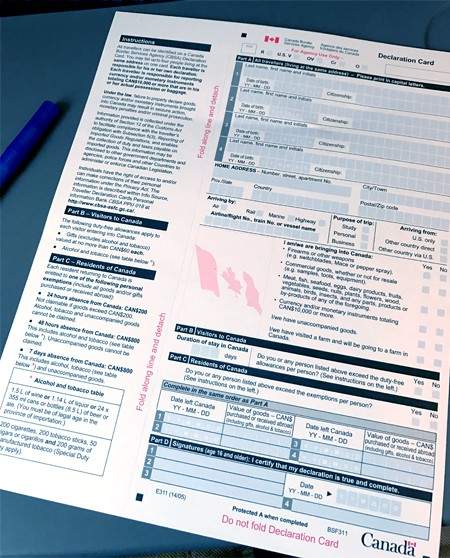
Visitors to Canada are expected to hand a completed Declaration Card to a border guard in order to cross the border. These cards, which ask basic questions about the visitor and their trip, are usually handed out on airplanes or trains. Visitors who cross a land border usually have to just tell the information to the guard.
Bringing Goods to Canada
It is illegal for foreigners to bring products into Canada to sell without first going through the complex procedures for engaging in international commerce . If you cross the border with more stuff than a reasonable person would assume you need for a trip, the authorities may conclude you are probably intending to illegally sell goods. The only exception is a maximum $60 worth of “ gifts .”
Tobacco and liquor products are counted separately, and foreigners can bring a fair bit of both into Canada. The current tobacco limit is quite generous; you can bring up to 200 cigarettes, 50 cigars, and 200 grams of tobacco, if you so choose. The liquor limit is stricter: you can only bring 1.5 litres of wine, 1.13 litres of another liquor, or a 24-pack of beer. Bringing food products into Canada is generally a hassle, as there are very specific rules and limitations for just about every type.
Dangerous goods, like guns , other weapons , and fireworks can be imported, but have their own particular rules. A few very specific things are likewise banned in Canada for safety reasons and are thus illegal to bring into the country, such as certain kinds of kites and baby products. A complete list can be found on the Canadian Government’s official prohibited consumer products list . It’s also illegal to import what the government describes as “obscenity and hate propaganda ” which includes any movies, books, comics, or magazines that contain, in the opinion of the border guard, overly hateful, perverted, gory, terroristic, or violent content.
- Alcohol and Tobacco Limits, Government of Canada
- Restricted and Prohibited Goods, Government of Canada
Traveling Inside Canada
Laws for foreigners.
This should hopefully go without saying, but foreigners have to obey Canadian laws while in Canada. Those who do otherwise can be charged, arrested, sentenced, and imprisoned just like Canadians. At the same time, the legal protections granted to Canadians by the Canadian Constitution also apply to foreigners visiting the country. This includes the right to avoid self-incrimination, the right to consult a lawyer, and the right to dispute before a judge any charges or fines imposed by a police officer.
Canada has extradition treaties with more than half the world’s countries , meaning foreigners who commit a crime in Canada but leave the country before they are caught or punished can be caught by local police and forced to return to Canada to face justice (and vice-versa). Only in very rare situations will a foreigner accused of a crime in Canada be tried and punished for it by their own country’s justice system.
Getting Around in Canada
Flights within Canada are notoriously expensive, with the average domestic flight costing at least $300, plus airport fees and taxes which usually add an additional $40 or so. The country has three national airlines, Air Canada (airline codes: 014, AC or ACA, part of the Star Alliance airline coalition) and WestJet (838, WS, WJA, part of its own 16-airline alliance ) which are largely domestic, and Air Transat (649, TS, TSC) which is mostly international. Canada does not have a major discount or budget airline, though in recent years the major airlines have been experimenting with budget spin-offs, such as Air Canada Rouge and Westjet’s Swoop . Flights to northern Canada , and especially within northern Canada, are extremely expensive, often a thousand dollars or more, and to get to certain remote regions travelers must use a special northern airline or a chartered flight.
Every major Canadian city has its own international airport , and many smaller cities too. There are also several considerably smaller regional or domestic airports that exclusively service flights between Canadian cities. Most of Canada’s big city airports are located around 20 kilometers from their city’s downtown core, or about a 30 minute drive. Vancouver and Toronto have trains that go directly from the airport to downtown.
- Security Screening at Canadian Airports, Canadian Air Transport Security Authority
The railroad played an important role in Canadian history , but trains have now become among the slowest, most expensive ways to travel the country. While trains can be a somewhat convenient way for tourists to travel between large Canadian cities located relatively close to each other, air travel or driving remains much more popular, and may even be cheaper.
VIA Rail is Canada’s primary passenger train service, offering direct service from Vancouver to Toronto (at over 4,000 km, one of the longest train trips in the entire world!), Toronto to Montreal, and Montreal to Atlantic Canada, with stops in all significant cities along the way. Traveling between the axis of Toronto, Ottawa, and Montreal is a popular route. A cross-country Canadian train ride, from one end of the country to the other, will take about four days and cost around $500-$800.
VIA Rail’s Vancouver, Toronto, and Montreal stations also offer connecting trips to the United States, via Amtrak . Several provinces also have limited train service to some of their more remote areas. Cruise-like luxury train services are provided by Royal Canadian Pacific for those willing to pay.

A Via Rail passenger train takes a break in Blue River, British Columbia. joseph s l tan matt/Shutterstock
Driving in canada.
Anyone driving a car or motorcycle in Canada must possess a valid driver’s license . A foreign driver’s license will generally be recognized as valid by the police if it can be read by them, which is to say, if it has English text on it. Don't forget to check if your car insurance applies in Canada!
Car and Bus Travel
Canada is united by a massive cross-country highway known as the Trans-Canada Highway that extends 7,821 km from the farthest western portion of British Columbia to the farthest eastern part of Newfoundland. It is primarily a west-east corridor, however. Though the Trans-Canada highway does have some northern forks, these do not go very far and none reach Canada’s northern territories . Every province has its own highway system as well, and these often merge into portions of the Trans-Canada highway. Through a combination of national and provincial highways, virtually every part of Canada is reachable by road travel, though in many cases drive times will be incredibly long.
- Trans-CanadaHighway map, Transport Canada
Many tourists enjoy traveling between Canadian cities by charter buses , which are large, comfortable buses featuring modern amenities such as bathrooms and WiFi. In eastern Canada, Greyhound is the dominant charter bus line. Other provinces are serviced by various regional bus companies.
Public Transportation
Most large Canadian cities have relatively sophisticated public transportation systems, with some combination of bus, light-rail train, monorail, subway, street car, and ferry services that can be used to navigate most of the downtown core and surrounding areas. The exact combination of services will vary from city to city (as will the cost of tickets and passes). In most cases, public transportation does not travel to rural areas, though some rural communities may have their own public transportation system.
Shopping in Canada
Canadians use the Canadian dollar (symbol: $ ) to pay for goods and services, which can be obtained at any ATM machine, which can be found at banks, shopping centres, corner stores, and many other public places. Most Canadian ATMs will accept foreign bank cards, though withdrawal fees can be high. Some smaller, independently-run shops will have a strict “cash only” policy, but these days, most Canadian business will actually prefer to do transactions through credit or debit cards . Visa and Mastercard are the most commonly-used credit card brands in Canada, and many shops will not accept other kinds — though some will, making it a good idea to ask ahead of time.
US dollars are often accepted at Canadian stores, particularly in tourist-heavy areas. Some places may have a policy of accepting US dollars “at face value,” however, meaning American money will not be accepted at its exchange rate worth, but rather treated as if it was worth as much as Canadian money, which is a bad deal.
Foreigners will be charged sales tax on every purchase they make in Canada, through special “value-added tax” known as GST and either PST or HST . Canada does not have a rebate program allowing foreigners to get a refund for the GST, PST, or HST they spend in Canada.
Challenges, dangers and annoyances when visiting Canada
Medical costs.
Though Canada offers generous public healthcare insurance, you have to be some form of long-term, legal Canadian resident before the government will pay for your hospital visits or operations. Non-residents will be billed full cost for any medical service performed while in Canada, which is why it always pays to get travelers’ medical insurance .
Canada has some of the world’s cleanest tap water and strict laws to ensure the cleanliness and safety of any meat, dairy, or poultry products sold at restaurants or grocery stores.

No foreigner will be denied emergency medical service in Canada, though if they have no insurance they will later face a hefty bill. In addition to hospital admittance and treatment, the uninsured should be prepared to pay full cost for things like ambulance rides and hospital beds. Seen here, a sign in a Vancouver hospital emergency room.
Staying Safe in Canada
Canada is generally a safe country, but it has some dangerous places. Every large Canadian city will have a couple of “bad neighborhoods” where criminals tend to congregate and locals generally avoid — particularly after dark — for fear of being harassed, robbed, or assaulted. Unfortunately, these neighborhoods can often be located close to tourist areas, and may seek to take advantage of the obviously confused or foreign. At the same time, most serious, violent crime in Canada tends to occur between people who know each other. Visitors who act confident and use caution and common sense should have little to fear.
Leaving belongings unattended in any public place is generally considered a high-risk activity, and though some businesses may store forgotten items in a “ lost and found ” collection of lost property, the police — and indeed, most Canadians — will generally be unsympathetic to victims of theft caused by inattentive behavior. People generally lock up their homes, cars, and bicycles before leaving them unsupervised. In rare cases, tourists and locals may be targeted by scam artists looking to cheat them out of money. In big cities, most scams are quite brazen, and usually take the form of a stranger asking for money on some sympathetic pretext, such as a phony personal emergency or phony charity. In some cases, a thief may attempt to quietly sell stolen goods to a stranger. Beggars can be common in some large Canadian cities as well. Many Canadians regard them with indifference, believing them to be scam artists.
The police can be called anytime in Canada by dialing 9-1-1 on the telephone. Canadian police are obligated to treat crimes committed against foreigners exactly the same as crimes against Canadians.
- Scams in Canada, TravelScams
More About Canadian Tourism
- Destination Canada, the Government of Canada's Official Tourism Department
- Explore Canada Instagram Account
- Lonely Planet Canada
Exchange Rate for one Canadian dollar (as of April 2019)
- $0.75 U.S. Dollar
- £0.57 U.K. Pound
- $1 Australian Dollar
- ¥5.02 Chinese Yuan
- ¥83.5 Japanese Yen
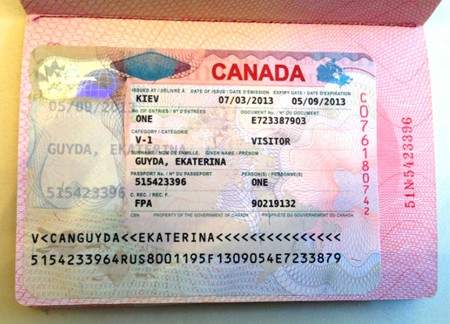
Canadian Travel Visas are special holographic stickers that are attached to a blank page of the passport.
Language selection
Wxt language switcher.
- Français fr
- Search and menus
WxT Search form
Travel and tourism statistics.

- Mobile applications
Sign up to My StatCan to get updates in real-time.
Find data on

More related subjects: Travel and tourism
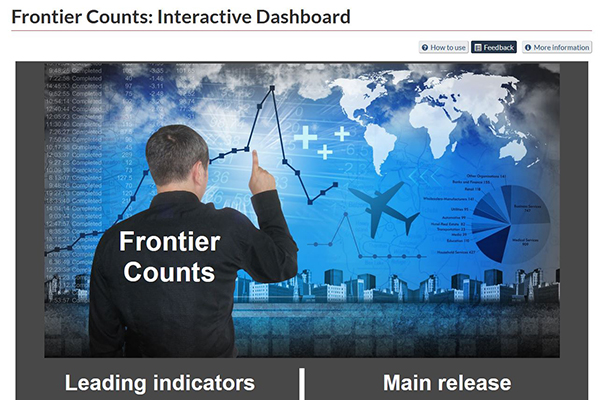
Frontier Counts: Interactive Dashboard
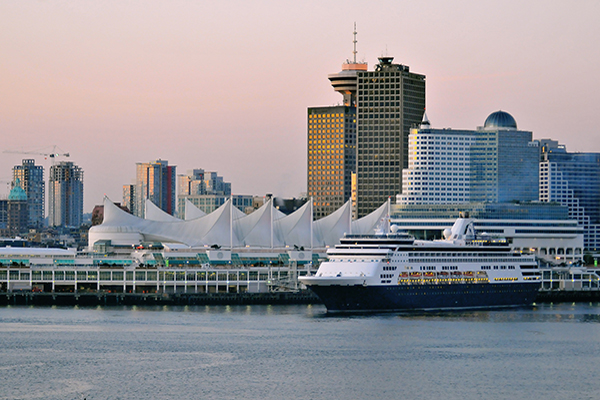
The wind is blowing: the number of cruise landings in 2023 exceeds pre-pandemic levels
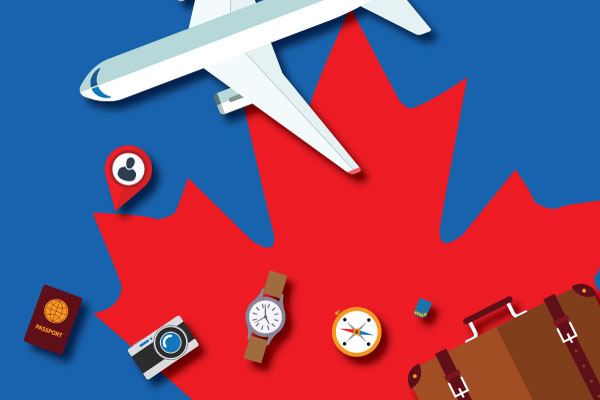
The impact of the COVID-19 pandemic on inbound visitors to Canada

Measuring private short-term accommodation in Canada
Key indicators | All indicators
Changing any selection will automatically update the page content.
Selected geographical area: ~ ' ' ~ Canada ~ ' '; ?>
- Tourism share of gross domestic product - Canada (First quarter 2024) 1.59%
Latest releases

View the latest Daily releases on the subject of travel and tourism .
Air passenger traffic and aircraft itinerant movements at Canadian airports

The interactive Dashboard for Air Travel is based on estimates from the Airport Activity Survey and the Aircraft Movement Statistics Survey. The Airport Activity Survey collects data on passengers enplaned and deplaned and cargo loaded and unloaded at Canadian airports. The Aircraft Movement Statistics Survey collects data on aircraft movements in Canada. Transportation Statistics: Interactive Dashboard
Canadian Tourism Activity Tracker
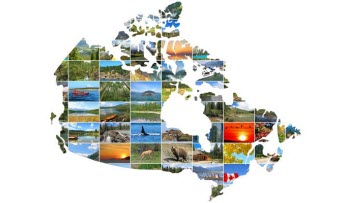
The Canadian Tourism Activity Tracker was an experimental product designed in 2021 to assess recovery of tourism activity in Canada. As currently designed, the Tracker has fulfilled this purpose and will no longer be updated after the December 2022 release.
About the Tourism Statistics Program
The Tourism Statistics Program produces detailed statistics on travellers travelling to, from and within Canada, as well as information on travellers' characteristics and spending. The program also provides information to the Canadian System of Macroeconomic Accounts which produces data on travel and tourism expenditures, employment and gross domestic product.
- Destination Canada
- Tourism HR Canada
Provincial and territorial tourism departments
- Government of Canada
- Newfoundland and Labrador
- Prince Edward Island
- Nova Scotia
- New Brunswick
- Saskatchewan
- British Columbia
- Northwest Territories
What do you want to see on this page? Fill out our feedback form to let us know.
Language selection
- Français fr
Government of Canada to announce support for Bonavista Peninsula tourism industry
From: Atlantic Canada Opportunities Agency
Media advisory
The Honourable Gudie Hutchings, Minister of Rural Economic Development and Minister responsible for ACOA, will make an announcement regarding seven tourism investments in the Bonavista Peninsula region. Also speaking will be Churence Rogers, Member of Parliament for Bonavista-Burin-Trinity.
Trinity, Newfoundland and Labrador · September 19, 2024 · Atlantic Canada Opportunities Agency (ACOA)
Date : September 20, 2024
Time : 1:30 p.m. (NDT)
Location : Rising Tide Theatre 40 West Street Trinity, NL A0C 2S0
Connor Burton
Press Secretary
Office of the Minister of Rural Economic Development and of the Atlantic Canada Opportunities Agency
Paul McGrath
Director of Communications
Atlantic Canada Opportunities Agency
709-689-5731
Page details
Travel a well-worn path to Alberta’s history-rich ranches
You can save this article by registering for free here . Or sign-in if you have an account.
Reviews and recommendations are unbiased and products are independently selected. Postmedia may earn an affiliate commission from purchases made through links on this page.
Article content
Just as the sun peaked above the plains, I wandered to the edge of the bluff and peered into the peaceful valley below. A handful of crimson-red buildings – a couple of barns, a cookhouse, a chophouse, a post office, and more – stood in the clearing, a thin sheen of fog hung overhead, and the snow-dusted mountains rose-red in the distance. A wispy column of smoke drifted through the aspens near the creek – the round-up fire – and the sweet scent of coffee lingered in the air. After taking in this idyllic southern Alberta scene at the historic Bar U Ranch this “cowboy” gathered up his belongings, strode down the hill, and headed for the warmth of the fire.
Subscribe now to read the latest news in your city and across Canada.
- Unlimited online access to articles from across Canada with one account.
- Get exclusive access to the Calgary Herald ePaper, an electronic replica of the print edition that you can share, download and comment on.
- Enjoy insights and behind-the-scenes analysis from our award-winning journalists.
- Support local journalists and the next generation of journalists.
- Daily puzzles including the New York Times Crossword.
Create an account or sign in to continue with your reading experience.
- Access articles from across Canada with one account.
- Share your thoughts and join the conversation in the comments.
- Enjoy additional articles per month.
- Get email updates from your favourite authors.
Sign In or Create an Account
Indeed, the 140-year-old Bar U Ranch, an icon in Alberta’s rich ranching history, is certainly a great little photo op from the visitor centre. However, as good as the picture is, visiting the ranch, touring the beautifully restored buildings, hearing the ancient “open range” stories around the crackling fire and sipping a hot and steaming cup of cowboy coffee doubles the reward.
I’m a sucker for the rolling ranchlands of Alberta. Yes, they certainly photograph well. And there is something tried and true, rich and rewarding when it comes to exploring an old working ranch. And, unquestionably, if you want a quick immersion into ranching ways, a visit to the Bar U should be on your radar. There is no other historic ranch in the province that is this well-preserved and open for the public to experience. (The Bar U Ranch is located approximately an hour south of Calgary near Longview and just off the Cowboy Trail, or Highway 22. Fall, in my opinion, is the best time to visit. Adult admission is $13.25 and the ranch is only open until the end of September.)
Owned and operated by Parks Canada, the Bar U Ranch was one of the first of the massive corporate ranches established in the 1880s. Through the years, multiple owners and personalities – Fred Stimson, George Lane, Pat Burns, and the legendary cowboy John Ware, to name a few – have all called the ranch home.
Your weekday lunchtime roundup of curated links, news highlights, analysis and features.
- There was an error, please provide a valid email address.
By signing up you consent to receive the above newsletter from Postmedia Network Inc.
A welcome email is on its way. If you don't see it, please check your junk folder.
The next issue of Noon News Roundup will soon be in your inbox.
We encountered an issue signing you up. Please try again
Also, the original owner, Fred Stimson, established a strong relationship with the local Blackfoot and Stoney people and hired many Indigenous riders during his tenure. Many of them, together with their families, lived on the ranch. That strong relationship with, really, the first “ranchers” of this land continues to this day.
For me, the highlight is always sitting around the fire, sun sifting through the trees, and lingering in this historic setting where many legendary cowboys have found their respite. On my recent visit, Mariam, a longtime interpreter at the ranch, told numerous stories of the big round-ups, before barbed-wire fencing and private land deals restricted the open-range movement of cattle. She told how Pat Burns, one of the “Big Four” cattlemen in Alberta, could, at one time, ride from Cochrane to the U.S. border and never leave his land.
Of course, remnants of Alberta’s ranching history can be found throughout the province. In Calgary, for example, every day hundreds of people walk and cycle past the old mansion at Bow Valley Ranche in Fish Creek Provincial Park. (Pat Burns purchased this house from William Roper Hull in 1902 and it’s quite possible the idea of the Calgary Stampede was first conceived in this stunning home.) The turn-of-the-century parties in this mansion, involving dignitaries and the who’s who of the ranching community, were legendary. If you’ve had dinner in this regal home (it’s now one of the finest restaurants in Canada) or had a coffee and lingered in the pine-lined corridor near Annie’s Cafe, you have, to some extent, experienced a little taste of our ranching roots.
Glenbow Ranch Provincial Park, located northwest of Calgary on the way to Cochrane, is another great place to dive into Alberta’s ranching history. The many paved and shale-covered trails of the park, which used to be part of the historic Cochrane Ranch, are a favourite for cyclists and hikers alike. The views from this ranch, a 3,200-acre parcel of stunning ranchland sold to the province in 2004 by the Harvie family, are spectacular. In addition to the awesome trails, a visitor centre, ruins from an old townsite and quarry, and plenty of wildlife are also highlights of a visit.
Obviously, for many wannabe cowboys, visiting a working ranch and hopping on a horse might be the ultimate way to experience our Western ways. And, rest assured, there are many opportunities to do this in the Calgary area. I’ve hit the trails at M&M Ranch (Moose Mountain Horseback Adventures near Bragg Creek), Boundary Ranch (near Kananaskis village), and the amazing Anchor D Ranch (approximately 15 kilometres west of Turner Valley).
Without a doubt, my horseback riding adventure, which took place approximately 15 years ago, at Anchor D with the entertaining ranchman Dewy Mathews at the helm (he’s “Mantracker’s” cousin) is one of my fondest “ranching” memories. I had my young twin boys with me, Nelson and Aemon, and we rode up a gorgeous pine-peppered spine on the edge of K Country. On the way back to the ranch, Dewy stopped at a high point overlooking the stunning peaks and I took a bazillion photos. I seem to do this every time I’m at a ranch in southern Alberta.
Andrew Penner is a freelance writer and photographer based in Calgary. You can follow him on Instagram @andrewpennerphotography
Postmedia is committed to maintaining a lively but civil forum for discussion. Please keep comments relevant and respectful. Comments may take up to an hour to appear on the site. You will receive an email if there is a reply to your comment, an update to a thread you follow or if a user you follow comments. Visit our Community Guidelines for more information.
Braid: City council is about to spend $850 million and get nothing for it. Even the feds would blush
Smith insists she wants to work with city on green line — but the alignment has to change, nelson: accountability at city hall departed in 2019 along with former manager, calgary police arrest man for carjacking who'd been released from custody 16 hours earlier, bell: smith ucp to city council, play ball on green line or it's dead.
This website uses cookies to personalize your content (including ads), and allows us to analyze our traffic. Read more about cookies here . By continuing to use our site, you agree to our Terms of Service and Privacy Policy .
You've reached the 20 article limit.
You can manage saved articles in your account.
and save up to 100 articles!
Looks like you've reached your saved article limit!
You can manage your saved articles in your account and clicking the X located at the bottom right of the article.

IMAGES
COMMENTS
Tourism in Canada - statistics & facts. The tourism industry includes both domestic travel, in which residents of a country travel within that country, and international travel. It can also be ...
What We Do. Encourage the development of tourism in Canada. Promote positive measures that help the industry grow and prosper. Represent tourism interests at the national level. Support policies that will benefit the sector's growth and development. Lead the Canadian tourism industry to be the most competitive in the world.
In April 2020, Canada's airlines reported a year-over-year drop of 97.0% in passengers carried. Just over two years later, in May 2022, the 5.3 million passengers on scheduled and charter services reported by Canada's major airlines were the highest monthly total since before the pandemic. The industry has now recovered over three-quarters ...
Fueling Canada's hosting economy. The Canadian Tourism Data Collective is a new, centralized national platform that will serve as a two-way street for sharing and accessing tourism data. The Data Collective harnesses the power of data, research, and insights (and that's a lot of power!) and shares information in an accessible and secure ...
Travelweek is Canada's travel trade news source with travel news, jobs, travel industry events, FAM trips and travel agent contests.
About TIAC. Founded in 1930 to encourage the development of tourism in Canada, TIAC serves today as the national private-sector advocate for this once $105 billion sector. Based in Ottawa, TIAC takes action on behalf of Canadian tourism businesses and promotes positive measures that help the industry grow and prosper.
Destination Canada's 2030 Strategy: A World of Opportunity. Destination Canada provides intelligence, tools and resources that help the Canadian tourism industry reach domestic and international markets. Destination Canada's approach focuses on markets where Canada's tourism brand leads and yields the highest return on investment.
Tourism In Canada. Destination Canada produces regular data, market intelligence and industry analysis to help businesses market to international travellers and grow Canada's tourism industry. Most reports are updated monthly, quarterly or annually depending on the report type. Ad hoc reports, such as information on sectors are published as ...
News release. New strategy will foster growth and competitiveness of the tourism industry. July 4, 2023 - Niagara, Ontario. Tourism powers the Canadian economy, creating good jobs in every region of the country, from rural and remote communities to the largest cities. Tourism is also highly inclusive. Compared to other sectors, it employs a ...
the greatest impact on the travel and tourism industry in Canada over the next one to three years. Long-term trends were also identified as part of the process to anticipate adaptive measures for the industry moving forward. introduction Assess the impact of the COVID-19 pandemic on the industry 01 While the pandemic brought Canada's tourism
Canada's tourism industry is an important contributor to Canadian economic growth. This industry - which comprises hospitality and travel services to and from Canada - is a multi-billion-dollar business that employs hundreds of thousands of Canadians and is supported by all levels of government.
The Travel & Tourism market in in Canada is projected to grow by 2.26% (2024-2029) resulting in a market volume of US$19.04bn in 2029. ... Canada's Travel & Tourism industry is heavily impacted by ...
Travel and tourism data. The Canadian Tourism Data Collective went live in May 2024. It provides real-time insights, data and analytics. This in turn will fuel the growth of Canadian tourism. Visit the Statistics Canada website to find important data about travel and tourism in Canada.
Canada's tourism industry is showing strong signs of recovery and is on target to contribute more than $162 billion to the country's economy in 2023. New economic impact research from the World Travel & Tourism Council (WTTC) shows that the Canadian travel industry is within striking distance of its 2019 pre pandemic peak of $173.9 billion ...
Yukon. Canadians love to spend on travel and tourism. Even as dark clouds formed above the economy, this spending continued largely unabated for much of 2022 and into 2023. After being unable to travel for more than two years during the height of the pandemic, pent-up demand helped to set the pace of the tourism industry's recovery.
GBTA's Canada Conference spotlights the resurgence in business travel spending, evolving industry trends, recognition of association volunteers and introduction of new regional leaders Business travel in Canada is poised for a strong, evolving future, according to the takeaways and forecasts unveiled during the Global Business Travel Association (GBTA) Canada Conference…
Keep listening to the Voices of Travel . From the 'rock 'n' roll, wild west days' days of the 1980s to the challenges the industry has faced over the past four decades, Canadian Travel Press' series, Voices of Travel: The Next Chapters has offered Canada's travel industry an inside look at the experiences and passion of some remarkable and well-known Canadian travel...
Canada's travel retail landscape is changing dramatically - so much so that ACTA is preparing a significant report due in October detailing a foundational shift in the industry that includes higher wages for employed agents, but new ones being hired as sole proprietors (aka independent agents). MORE
Travel Industry Statistics for Canadians. It is estimated that by the end of 2023, the Canadian travel industry will employ 1.64 million people. In 2022, the contribution of the travel industry to the Canadian economy grew by 41.4% compared to 2021. In June 2023, the number of visitors to Canada was 83% of the number in June 2019, showing ...
Over 18 million foreigners visit Canada every year making tourism an over $80 billion-a-year Canadian industry — bigger than lumber, fishing, and farming combined. ... Car and Bus Travel. Canada is united by a massive cross-country highway known as the Trans-Canada Highway that extends 7,821 km from the farthest western portion of British ...
About the Tourism Statistics Program. The Tourism Statistics Program produces detailed statistics on travellers travelling to, from and within Canada, as well as information on travellers' characteristics and spending. The program also provides information to the Canadian System of Macroeconomic Accounts which produces data on travel and ...
Watch Now! Porter Airlines Webinar SEP 28 2PM ET Join Porter's webinar and learn how we are turning the idea of economy air travel "upside down". Watch Now! Watch Now! ATELIER Playa Mujeres OCT 17 1PM ET Step into a barefoot-luxury virtual tour and experience our first-hand latest updates. Watch Now!
Among the latest developments is the July 17 enablement of Air Canada NDC content with Sabre, which provides access for the majority of the airline's travel trade partners to a production-ready ...
Trinity, Newfoundland and Labrador · September 19, 2024 · Atlantic Canada Opportunities Agency (ACOA) The Honourable Gudie Hutchings, Minister of Rural Economic Development and Minister responsible for ACOA, will make an announcement regarding seven tourism investments in the Bonavista Peninsula region.
Just as the sun peaked above the plains, I wandered to the edge of the bluff and peered into the peaceful valley below. A handful of crimson-red buildings - a couple of barns, a cookhouse, a ...
In 2025, Travel Shops will expand even more, so anyone can create their own Shop." In addition to storefronts from travel influencers like Brett Conti, Renee Roaming, and Oneika Raymond, travelers can explore and book hotel collections from a select group of well-traveled partners, travel experts, media publications and brands: